

Which catamarans have daggerboards?
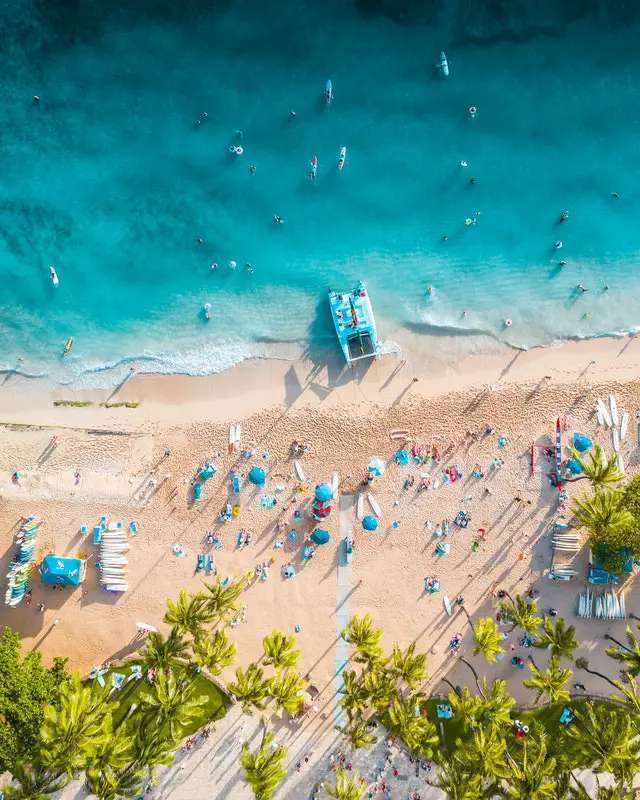
After researching catamarans we have made a list of catamarans with daggerboards. Performance means a great deal for us, so we are looking at the pros and cons of daggerboards, and would like to share our knowledge in this article. If you know of any boats that should be included in this article, please let us know.
Why choose a catamaran with daggerboards?
Daggerboard catamarans are usually higher performing than those without. Not only because of the daggerboard itself but due to the specific focus on performance especially in these types of vessels.
Usually, that focus also makes them lighter as the shipyards have tweaked the materials used to make them light. Often they are designed by the most renowned experts to make the best hulls.
The most important reason to choose daggerboards is performance. They sail closer to the wind when sailing upwind, and they are usually faster than those who focus more on comfort.
Not that daggerboard cats are uncomfortable, but the daggerboard compartment takes up a bit of space from the living area inside the hulls. And you will have to decide if it is worth the decrease in comfort compared to the enhanced performance.
Another reason for choosing daggerboards is the possibility to anchor on shallow waters, as when the daggers are lifted, the draught is often around 3’ or 1 meter or even less.
Catamarans with daggerboards
A list of catamaran models with daggerboards:
- Sud Composites
- Soubise / Freydis – Tournier Marine
French-built catamaran. Well sailing and luxurious.
Also French catamaran. Reviews are pretty good. Easy sailed.
Brazilian built catamaran from 2013. Only this model has daggerboards.
designer Philipe Pouvreau. 30 of them were built before 2008, and after that, a dozen more were built in various custom shipyards. One should therefore be aware of eventual modifications or deviations in the design of the later models.
But the quality is still great, also on the late models, and they have successfully circumnavigated, and are still.
Founded by Alan Adés in 1990, and in 1999 they signed with VLPL, a group of Architects who specialized in multi-hull designs for the competition.
This resulted in the Switch 51, a very well-performing catamaran, which amongst others are known for very decent speed in even moderate wind speeds. They did however not build that many, before switching to building custom catamarans.
Three main models, are still in production:
Soubise 49 Croiseur Soubise 56 Soubise 70
Is not very well known, 27 feet
- Scionning Known to be very high performance.
Benefits of having daggerboards on a catamaran
High performance (speed and efficiency in various wind directions. Especially in upwind directions.)
Can utilize shallow waters, with the boards raised. Typically 3 feet or even less, which means that you can anchor away from the crowd and walk ashore.
Generally, you will have much more anchorage space to choose between.
Disadvantages of daggerboards
More work, more to know and learn, their place in the boat may limit the comfort.
Costly. Adds around 30.000 $ to the construction price.
Why choose daggerboards over fixed keel?
The choice of having daggerboards is mostly a compromise between comfort and performance. Daggerboards make the cat able to sail closer upwind, and the boards are made to enhance the speed.
Boats with fixed keels are sometimes slower, usually also heavier, but also more comfortable, as they have more living space. And if you are sailing short passages, the heavy boat is a good choice.
But if you are going to cross the oceans, the difference in performance is remarkable. It can be several weeks longer crossings compared to higher performing cats.
Daggerboards are for sailors who expect to make longer passages, and who have some experience sailing.
Related Posts
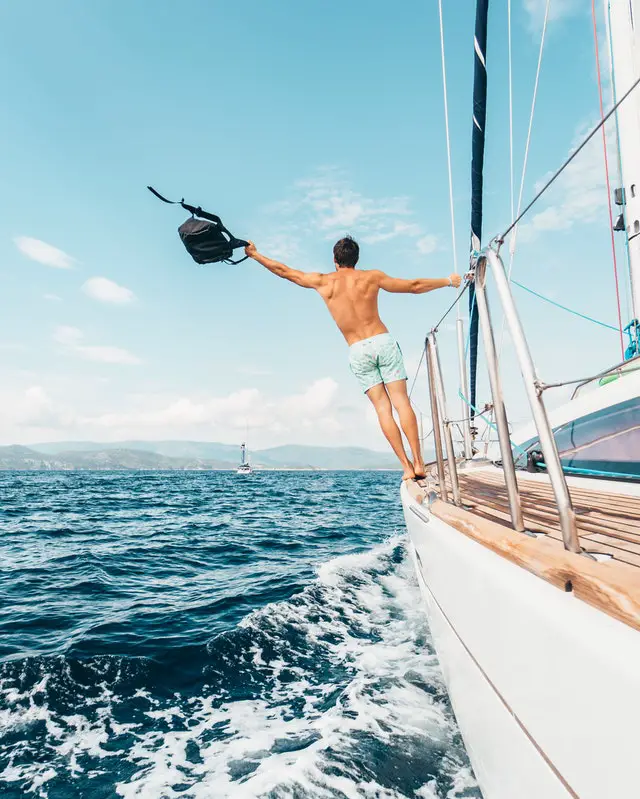
Should you own or charter a boat?
I could give you many reasons why not to buy a boat, but they would be the same reasons not to have a child. Unknown…
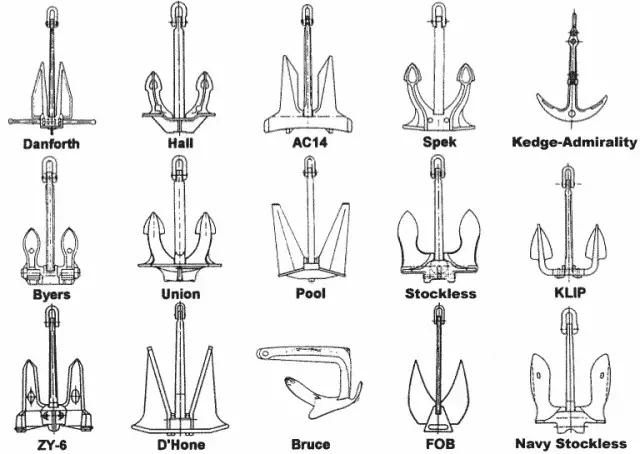
How Anchors Work and All You Need to Know about Anchoring
In this article, you will not only learn all the basics about anchors. You even get all the more advanced knowledge you need about how…
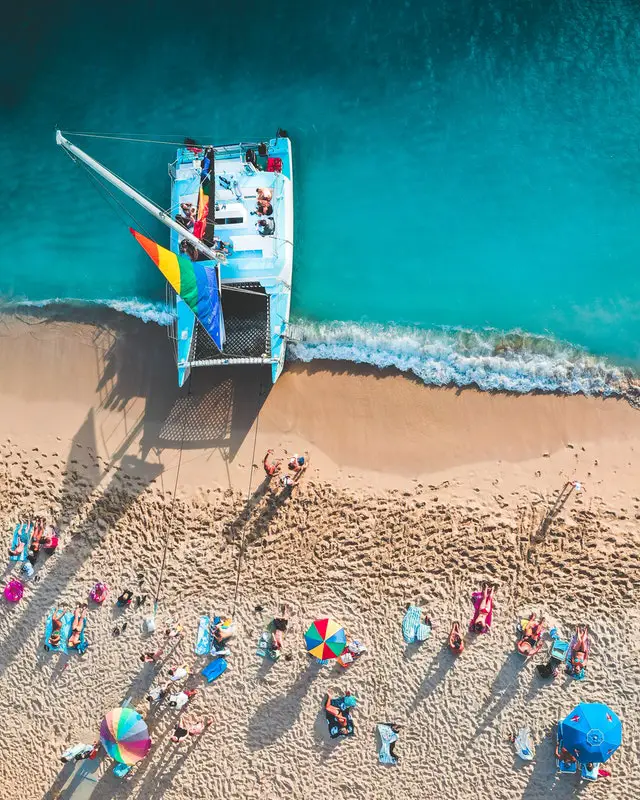
Why catamarans have trampolines
There are several reasons why trampolines are the right choice in catamaran design: It is lightweight, give little resistance to wind and water, is comfortable,…
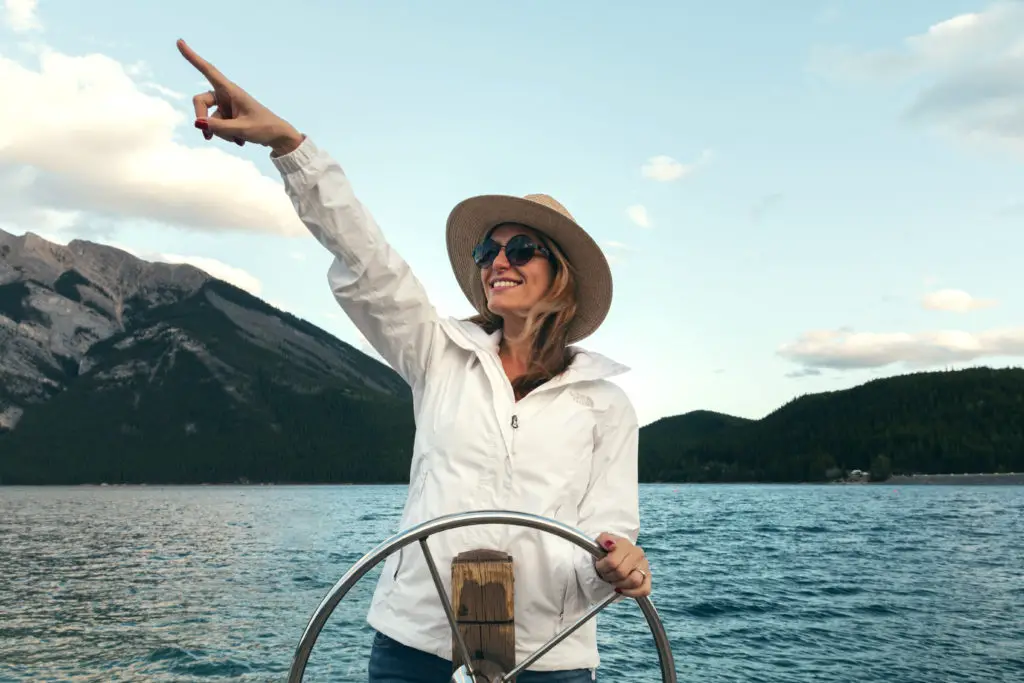
Tips for new sailors in 2022
Are you considering taking up sailing, then you may wonder if sailing is a dying hobby? In this article, we would like to answer some…

Be back soon!
This website is under maintenance. Check back tomorrow!
*If you’re the owner of this website and have questions, reach out to Bluehost. We’re happy to help.
- 0 No item in your cart
- SUBSCRIPTION
- Classified Ads
- Technical Specifications
- Destinations
- Address book

- All the magazines
HH60 - A high-performance catamaran with deep daggerboards and an extra-wide cockpit

Article published on 05/11/2021
By Emmanuel van Deth
published in n°SP17 dec. / jan.
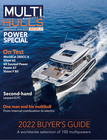
This latest HH project from Morrelli & Melvin retains the same silhouette of the other models in the range while affirming its ambitions in terms of performance: displacement remains modest and is associated with a powerful rig - this culminates at 94½ feet (28.78 meters) above the water...
Create a notification for "Catamaran"
We will keep you posted on new articles on this subject.
Upwind, the daggerboards can push the draft down to just over 13 feet (4.00 m): we suspect that upwind course-keeping will be exceptional. The deck layout has two particularities: firstly, a cockpit that is as wide as it is streamlined, and secondly, twin helm and maneuvering stations at mid-height. The protection of the area is ensured by three small independent biminis or one larger, more enveloping one.
Builder: HH Catamarans Length: 58’11” (17.95 m) Beam: 26’8” (8.12 m) Light displacement: 34,175 lbs (15.5 t) Draft: 4’3”/13’1” (1.3/4 m) Mainsail: 1,509 sq ft (140.15 m²) Solent: 750 sq ft (69.63 m²) Engines: 2 x 57 HP
www.hhcatamarans.com
Tags :
- HH 60 ,
- HH Catamarans
Did you like this article ?
Share this article
Most-read articles in the same category.
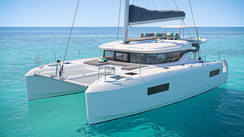
Lagoon 43 - To be discovered at Cannes!
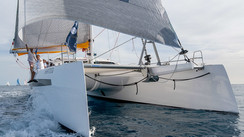
Multihull Fest - Fiesta time coming soon in Spain!
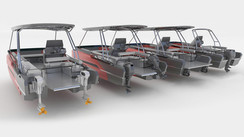
Korkyra 650 - A powercat in rotomolded polyethylene
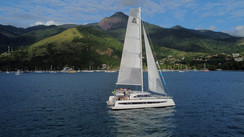
Sail Cat AG 49’ - Inverted bows made in Brazil
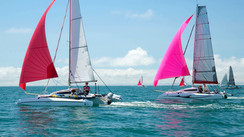
Astus Boats Club - Ask for the 2024 program!
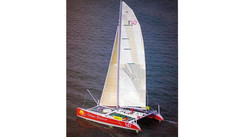
Message in a bottle - Where are you Optique Beaumont?
What readers think.
Post a comment
No comments to show.
Follow us on
Vous avez ajouté " " à vos favoris., vous avez supprimé " " de vos favoris., in order to add this article to your favorites, please sign in..
Did You Know That We Offer Contract to Closing Services? Click Here to Find Out More.
Need Marine Financing? Apply Here With Our Partner, First Approval Source
- Catamaran Interviews
- Catamaran Reviews
- Buying Advice
- Selling Advice
- Woods Design Advice
- Americat 3014
- Aquila 44 Yacht
- Balance 526
- Bali 40 Catspace
- Beneteau Blue II
- Broadblue 346
- Broadblue 38 Prestige
- Broadblue 385
- Broadblue 435
- Broadblue 46
- Catalac 10M
- Catalac 11M
- Catalac 12M
- Catalac 900
- Catana 42 S
- Chris White 48 Voyager
- Chris White 55
- Corsair F28 R
- De Villiers
- Dolphin 460
- Endeavour 30
- Endeavour 35 Victory
- Endeavour 36
- Endeavour 44
- Endeavour 44 TrawlerCat
- Fortuna 36 Island Spirit
- Fortuna 401 Island Spirit
- FP 32 Maldives
- FP 35 Tobago
- FP 37 Antigua
- FP 38 Athena
- FP 39 Fidji
- FP 40 Lavezzi
- FP 40 Lucia
- FP 40 Summerland MY
- FP 41 Lipari
- FP 42 Astrea
- FP 42 Venezia
- FP 43 Belize
- FP 44 Helia
- FP 44 Orana
- FP 46 Bahia
- FP 46 Casamance
- FP 48 Salina
- FP 56 Marquises
- FP 57 Sanya
- FP 60 Eleuthera
- FP Saona 47
- Gemini 3000
- Gemini 3200
- Gemini 3400
- Grainger 420 Mystery Cove
- Hirondelle 7M
- Lagoon 37 TPI
- Lagoon 42 TPI
- Lagoon 43 PC
- Leopard 39 PowerCat
- Leopard 45 Classic
- Leopard 47 PowerCat
- Leopard 51 PowerCat
- Leopard 53 PowerCat
- Maine Cat 30
- Maine Cat 41
- Matrix 450 Vision
- Matrix 760 Silhouette
- Maverick 400
- Maverick 420
- Maverick 440
- Nautitech 40
- Nautitech 442
- Nautitech 46 Open
- Nautitech 47
- Outremer 40
- Outremer 45
- Outremer 50 Standard
- Outremer 55
- Privilege 37
- Privilege 39
- Privilege 42
- Privilege 43
- Privilege 435
- Privilege 45
- Privilege 465
- Privilege 48 Transcat
- Privilege 482
- Privilege Serie 5
- Prout 31 Quest
- Prout 33 Quest
- Prout 34 Event
- Prout 35 Snowgoose
- Prout 37 Snowgoose
- Prout 37 Snowgoose Elite
- Prout 38 Manta
- Prout 39 Escale
- Royal Cape 45
- Royal Cape 530 Majestic
- Royal Cape Majestic 500
- Sailcraft 30 Iroquois
- Sailcraft 32 Comanche
- Sailcraft 35 Cherokee
- Sailcraft 41 Apache
- Sailcraft 44 Apache
- Wildcat 350
- Seawind 1000
- Seawind 1160
- Seawind 1200
- Seawind 1260
- Seawind 1600
- Solaris 36 Sunrise
- Solaris 36 Sunstar
- St Francis 44
- St Francis 48
- St Francis 50
- Stealth 11.8
- Heavenly Twins 26
- Ocean Twins 38
- Voyage 380 Maxim
- Voyage 400 Norseman
- Voyage 430 Norseman
- Voyage 450 Cabriolet
- Voyage 47 Mayotte
- Wharram 38 Tiki
- AMI 320 Renaissance
- Woods 22 Wizard
- Woods 35 Banshee
- Woods 35 Flica
- Woods 36 Scylla
- Woods 36 Vardo
- Woods 38 Transit
- Woods 40 Meander
- Xquisite X5
- Xquisite X5+
Catamaran Daggerboards and Keels – Woods Interview # 9
- Post author By Diane Selkirk
- Post date March 27, 2021
- No Comments on Catamaran Daggerboards and Keels – Woods Interview # 9

I am with Richard Woods, and we are talking about catamarans. He’s a legendary catamaran designer and experienced catamaran sailor of many different designs. This is one of several interviews we’re having on different topics. Today, we’re talking about daggerboards versus keels. Richard will tell us a little bit about how daggerboards work, how keels work, and what some of the benefits of each are.
For more from Richard Woods, please go to his website .
Richard, can you start off with what dagger boards and keels do for a boat?
There’s the three basic ways of preventing leeway, which is what you’re going to be doing with a multihull. On a monohull you’ve got the keel. Essentially, it’s for stability to balance the heeling, to stop the boat heeling too much. You don’t have that as a problem on a multihull. You are just trying to stop leeway.
You can do it either with using the hull shape, which would be like a Catalac or Wharram catamaran. Then the next would be to have keels. The third would be to have daggerboards.

You could essentially say that a catamaran with keels is a bit like a long-keel monohull, and the daggerboard catamaran is a fin keel monohull in more terms. I think we all know and all agree that the best sailing boats are going to be the one with fin keels. Then progressively a long-keel boat or keel or one with low aspect-ratio keels on the catamaran, that would be the next best. Then the one relying just on hull shape, whether it’s a test barge or a Catalac is going to be the the least good.

There’s two things on that. One is that the daggerboard prevents leeway better, but also prevention of or reduction of pitching, increasing potential top speed. You want to have buoyancy at the ends of the boat and not in the middle. You imagine a diamond shape sailing to windward, and it pitches up and down, up and down, and you end up hobby-horsing. Whereas a boat with fuller ends isn’t going to do that. Unfortunately, the thing with their keels, is that the buoyancy is more in the middle of the boat.

So there’s the two factors: one is the the sea kindliness of having daggerboards, and the other is the better performance.
A daggerboarded boat is always better, but it does have some disadvantages. The main one is that if you want to beach your boat or dry it out. To me, that’s always a major advantage of a multihull. You got to be able to have lifting rudders, and essentially, you don’t want your propeller to be the deepest part of the boat, or if you’ve got an inboard engine.
The daggerboarded boats work really well when you’ve got outboard engines and when you’ve got tiller steering, because it makes it easier to get the rudders. It is still possible on bigger boats and you can also have a bit of a compromise of having a small keel, and then the daggerboard. Or you can have like your boat was, which had daggerboards in the lead hull, so you didn’t need to lift the rudders. The rudders are still higher than the bottom of the keel.

Although there’s a lot of places in the world where you don’t have to beach the boat, the most obvious to say: the Great Lakes in North America, Florida, the Bahamas, most of the Caribbean in fact, you don’t have to. The Mediterranean. They don’t have tides and so you’re not in the beach.
I’ll just show you this. I’m just going to turn the camera around a bit now. As you can see, this is our house now. In fact, it’s low water and we have about an 18-foot tidal rise, so that’s more than you. It actually is neat, so it goes up quite a bit further. But we are used to drying out for six hours a day, every day when we moor our boats. So for us, it’s much more important to have good protection for the bottom of the boat.
If you’re sailing in Florida and then you sail up to say, Cape Maine, you suddenly get to the box and you get this 10, 12-foot tide, and you do want to go around, either deliberately or what not. With daggerboarded boats, you’ve got to think about a lot more when you’re beaching a boat.
The interior room, you might think that was a problem. But usually you can make the daggerboard, say, fit around the side of a heads compartment, or the galley worktop, or something like that, so it’s never really a problem. You can have the dagger board on the inside or the outside of the hull, it doesn’t seem to make much of a problem either.

But the other thing is that the daggerboards are more expensive to make because you’ve got to make the daggerboard case, which is in effect, same as making a keel. Then the daggerboard and then the controls for the daggerboard, so that all adds to cost and complication.
And there’s definitely a learning curve to knowing how to use the daggerboard effectively, and have that experience. So are they less of a beginner kind of attribute on a catamaran and more of a somebody who’s been sailing for a while?
Yes. There’s no point really, in having daggerboards if you’re not going to use them. Essentially, that means having them in simplest, both down sailing to windward, and then lift the leeboard when you’re reaching, and lift both when you’re sailing downwind. That’s the normal.
But you can have the position of, if you’re sailing in big seas, especially big quartering sea downwind, the tail wags the dog. In other words, the rudder steers, and it’s not actually doing anything, because there’s no hull in the water. Then, it makes it a lot easier having the daggerboards both half down.

So yes, you learn quite quickly how your boat behaves according to whether the daggerboards are up or down.
The other thing that I found, is that a lot of people, when they break a daggerboard, it tends to be the lead daggerboard that breaks. When you’re sailing, that’s the side that gets powered up when you’re pushing down on being hit by a wave, and pushing sideways tends to break the daggerboard.
Of course the other thing is, it’s quite a good ultimate echo sounder. We have never actually broken a daggerboard, on any boat, I don’t think. When we were, this is a good excuse because it was an unmarked reef, but we were sailing off Nicaragua, and we were sailing at eight knots. We hit a reef with the daggerboard and the boat stopped dead. In fact, my wife fell over. It was driving a car at 10 miles an hour into a wall, sort of effect, and once we sorted ourselves out, and we lifted the daggerboard, we lost about the trailing edge, about a foot by four inches being totally destroyed. We had a mill u-volt, a 5/16th u-volt, as an up haul, and that was bent completely flat by the force of the boat stopping.
I guess it was a sacrificial item!
We still sailed.
Right. That’s what I’m thinking. Rather than hitting the reef with your boat, you hit it with something sacrificial. They can be expensive to replace, but…
Yes. We didn’t hit it with the boat, no. We hit it with something that we could carry on for another three months before we actually had it taken out of the boat and repaired.

Of course, that’s always something. If you can take the broken bit to the mechanic, or to the boat yard, that’s always better than doing it the other way around. Usually, you can carry on sailing with one daggerboard or two half-daggerboards, whatever, but it is quite a common problem.
As I say, if you’ve got a conventional inboard engine with fixed rudders, there are quite a lot of multihulls around, even here, but they’re treated like monohulls. You can’t, for example, go to the Scilly Isles and go to Hawaii, and Green Bay, which is a wonderful place to spend a lifetime, really. It’s the nearest the equivalent of going into the Bahamas. But you can’t do that if you’ve got a boat you can’t dry out.

I guess that’s why multihulls became so much more popular in the UK before other places.
Everything in design, it’s always interconnected. Going back to the comfort, and the rolling. If you look at the Scilly Isles, which are 30 miles off the Southwest corner of England, sort of like saying you’re going out of Miami, and there’s the Bahamas. It’s not quite that far, but it’s pretty near the same as going to Bimini.

There’s a whole stack of islands, but the pilot guide says there is no safe anchorage, because it was written by a monohull sailor. We’ve been and they say, “You know, if you go into this anchorage, then you’re going to be as protected as you can be.” We’ve been into those anchorages, and they’ve been horrible, because you’re open to when the tide’s in. You’re open to the ocean because when they’re out, it’s out in the Atlantic. When you can dry out, you go onto these lovely sandy beaches, and you can dry out and you’re safe then.
Well that’s cool. So thank you Richard, that was fascinating on daggerboards and keels.
- Tags Buying Advice , Richard Woods

By Diane Selkirk
I love to travel and have spent the past seven years sailing with my family aboard our 40 Woods Meander catamaran - traveling from B.C.'s north coast, to the west coast of the US, Mexico, the South Pacific, Australia, New Zealand, South East Asia, across the Indian Ocean to South Africa and on to St Helena, South America, the Caribbean and Central America.
Leave a Reply Cancel reply
Your email address will not be published. Required fields are marked *
Save my name, email, and website in this browser for the next time I comment.
Catamarans with Daggerboards: Enhancing Stability and Performance
by Emma Sullivan | Aug 9, 2023 | Sailboat Lifestyle
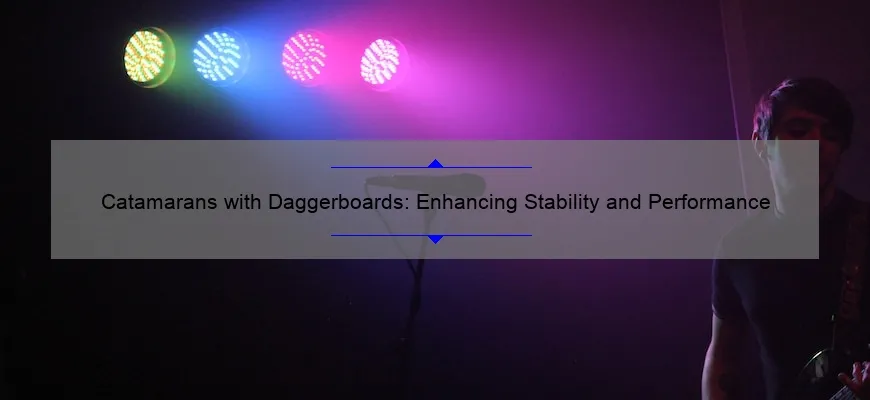
Short answer catamarans with daggerboards:
Catamarans with daggerboards are multihull sailboats consisting of two parallel hulls and vertical foils called daggerboards that can be raised or lowered. Daggerboards improve stability, reduce leeway, and increase upwind performance by minimizing side slipping. These high-performance catamarans are commonly used in racing, offshore cruising, and recreational sailing due to their enhanced speed and maneuverability capabilities.
How Catamarans with Daggerboards Enhance Sailing Performance
If you’re a sailing enthusiast, you may have heard about the growing trend of catamarans equipped with daggerboards. But what exactly are daggerboards and why do they enhance the sailing performance of these unique vessels ? In this blog post, we’ll dive into the details and give you a professional, witty, and clever explanation.
First things first – let’s understand what a catamaran is. A catamaran is a multi-hulled vessel consisting of two parallel hulls connected by a deck structure. Unlike traditional monohulls, catamarans offer increased stability due to their wider beam. This stability means more balance when sailing through choppy waters or in heavy winds . However, even with their inherent stability advantage, there’s always room for improvement when it comes to performance.
This is where daggerboards come into play. Daggerboards are vertically retractable underwater fins that can be found on both sides of a catamaran’s hulls. These boards mimic the functions of centerboards or keels found in monohulls, but with some key differences .
Unlike fixed structures on monohulls, daggerboards can be raised or lowered based on different wind and sea conditions. And trust us – this simple mechanism makes all the difference in terms of performance! By adjusting the depth at which the daggerboard extends below the waterline, sailors can optimize the flow of water around their vessel.
When cruising downwind or in lighter winds, raising the daggerboard allows for shallow draught navigation while minimizing drag created by unnecessary underwater surface area. On the other hand, when sailing upwind or encountering stronger gusts, lowering the boards increases lateral resistance and prevents sideways slippage known as leeway.
Essentially, daggerboards function as hydrofoils for catamarans . They create lift by exploiting Bernoulli’s principle – faster-moving air above generates lower pressure compared to slower-moving air below an object’s surface (or in this case, water). This lift effect counteracts the forces acting on the hulls and reduces slippage, thus improving both speed and control.
But let’s not forget about the clever engineering behind daggerboards. These modern-day marvels are crafted from lightweight yet durable materials such as carbon fiber or fiberglass, ensuring optimum strength-to-weight ratios while keeping performance at its peak. The adjustable nature of daggerboards also comes into play during maneuvers like tacking or gybing, making it easier for sailors to change direction smoothly without losing precious momentum.
So why should you care about catamarans with daggerboards? Simple – they offer a thrilling sailing experience with enhanced performance capabilities. Whether you’re seeking the adrenaline rush of competitive racing or just looking for a smooth cruise across open waters, these vessels provide unbeatable stability and speed that can take your sailing game to new heights.
In conclusion, catamarans equipped with daggerboards have revolutionized the world of sailing by maximizing performance through clever hydrodynamics and adjustability. So if you’re ready to enhance your sailing adventures with a touch of finesse and innovation, hop aboard a catamaran with daggerboards and prepare to ride the waves like never before!
Exploring the Benefits of Catamarans with Daggerboards Step by Step
Title: Exploring the Benefits of Catamarans with Daggerboards Step by Step
Introduction: Catamarans have gained widespread popularity in recent years due to their stability, speed, and spaciousness. One key element that maximizes the performance of catamarans is the presence of daggerboards . In this blog post, we will delve into the benefits of catamarans equipped with daggerboards, exploring each step involved. From improved sailing capabilities to enhanced comfort , let’s discover the remarkable advantages these sleek vessels offer.
Step 1: Understanding Daggerboards in Catamarans Daggerboards are vertically retractable appendages mounted on both hulls of a catamaran. Serving as underwater wings, they can be lowered or raised depending on sailing conditions. When deployed, daggerboards greatly contribute to a sailboat ‘s lateral resistance and stability.
Step 2: Heightened Stability at Sea One prominent advantage of catamarans with daggerboards lies in their exceptional stability. The wide beam between two hulls minimizes rolling motion even under rough sea conditions, offering an incomparable sense of security for those prone to seasickness or seeking a more comfortable cruising experience.
Step 3: Superior Upwind Performance Daggerboards revolutionize a catamaran’s ability to sail upwind effectively. By lowering both daggerboards symmetrically, the wetted surface area decreases, reducing drag significantly while maintaining lateral resistance. This enables catamarans with daggerboards to venture closer to windward than traditional keel-powered boats – an invaluable feature for sailors navigating challenging coastal or offshore routes.
Step 4: Enhancing Maneuverability When maneuvering close to shorelines or marinas, daggerboards provide heightened control and agility. Their adjustable nature allows sailors to alter their angle or completely retract them into the hulls when additional clearance is required – ensuring simple navigation through shallow waters or tight spaces where other vessels may struggle.
Step 5: Increased Speed Potential The presence of daggerboards in catamarans grants them superior speed capabilities, especially in reaching conditions. With reduced drag and improved stability, these formidable vessels can easily harness the power of the wind, gliding swiftly across open waters . Daggerboards enable a catamaran to maintain higher average speeds throughout long passages, ensuring quicker and more enjoyable journeys.
Step 6: Enhanced Safety Catamarans equipped with daggerboards boast enhanced safety features that make them an ideal choice for offshore cruising or adventurous sailing trips. By allowing sailors to control their draft depending on the sea state or desired performance, daggerboards minimize the risk of grounding or collisions with underwater hazards. This versatility enhances overall onboard safety and peace of mind.
Conclusion: Daggerboards are not merely another feature found in high-performance sailing vessels; rather, they revolutionize the way catamarans navigate through various conditions. From heightened stability at sea to improved maneuverability and increased speed potential, these retractable appendages offer unparalleled benefits for enthusiasts seeking comfort, agility, and thrilling experiences on the water . Next time you embark on a catamaran adventure, keep an eye out for those sleek daggerboards that make every voyage a remarkable one!
Frequently Asked Questions about Catamarans with Daggerboards
Are you considering purchasing a catamaran with daggerboards but find yourself overwhelmed with questions? Fear not! We have compiled a comprehensive list of frequently asked questions about catamarans equipped with daggerboards to quench your curiosity. From the advantages they offer to common misconceptions, we’ve got you covered. Join us as we delve into this intriguing topic.
1. What is a catamaran with daggerboards?
A catamaran with daggerboards is a type of sailing vessel that features two hulls connected by a platform known as the bridge deck. Unlike traditional catamarans, these innovative vessels are equipped with retractable keels called daggerboards which can be adjusted based on sailing conditions.
2. Why choose a catamaran with daggerboards over other designs?
Catamarans with daggerboards offer numerous advantages for avid sailors. Firstly, their ability to retract or extend the boards allows for enhanced maneuverability and increased speed in different weather conditions . This means greater control when sailing upwind or in shallow waters where other boat types might struggle.
3. How do daggerboards affect performance?
Daggerboards significantly improve sailing performance by reducing sideways drift (known as leeway) and increasing the lateral resistance provided by the keels. By adjusting their position according to wind direction, sailors can optimize their boat’s angle against prevailing forces and achieve higher speeds.
4. Do I need any special skills to handle a catamaran with daggerboards?
While operating any sailboat requires some level of skill and experience, handling a catamaran with daggerboards doesn’t demand extraordinary expertise. As long as you possess basic sailing knowledge and understand how to utilize the adjustable keels effectively, you’ll be able to harness the full potential of these vessels easily.
5. Are there any drawbacks to using daggerboards?
Although the advantages of using daggerboards significantly outweigh potential downsides, there are some considerations worth mentioning. Catamarans equipped with daggerboards may have a higher initial cost compared to other designs due to their specialized construction. Additionally, maintenance and repairs for the daggerboard mechanisms might require more attention.
6. Can I still sail a catamaran with daggerboards in shallow waters?
Absolutely! The retractable nature of daggerboards enables catamarans to navigate shallow waters with ease. By lifting the boards, you can safely venture into areas where conventional keels would prohibit passage, opening up new possibilities for exploration while maintaining stability.
7. Are catamarans with daggerboards faster than those without?
The adjustable nature of daggerboards does provide potential for increased speed, particularly when sailing close to the wind or upwind . The reduced drag caused by retracted boards allows these vessels to efficiently glide through the water, resulting in impressive acceleration and velocity that can outperform traditional catamarans.
8. Are there any misconceptions surrounding catamarans with daggerboards?
Indeed, a common misconception is that daggerboards are solely beneficial for racing purposes or experienced sailors seeking high-performance vessels . However, these boats are equally suitable for cruising enthusiasts looking to enjoy enhanced control, stability, and overall comfort during their nautical adventures.
In conclusion, choosing a catamaran with retractable daggerboards offers an innovative approach to sailing characterized by improved performance and adaptability across various conditions. Novice or seasoned sailors alike can make the most of these unique vessels while exploring shallow waters or harnessing greater speed capabilities. So set sail confidently on your next maritime adventure armed with knowledge about these fascinating catamarans!
Understanding the Mechanics Behind Catamarans with Daggerboards
When it comes to sailing, catamarans have gained considerable popularity due to their stability and speed. But what sets these sleek vessels apart from traditional monohull sailboats ? The answer lies in their unique design, particularly the incorporation of daggerboards. In this blog post, we will dive deep into understanding the mechanics behind catamarans with daggerboards, shedding light on why they are favored by sailors all over the world.
To begin with, let’s familiarize ourselves with the fundamental concept of a catamaran. Unlike monohulls that have a single hull cutting through the water, catamarans boast two parallel hulls connected by a platform or bridge called the trampoline. This setup enhances stability and prevents excessive rolling, making them an excellent choice for those looking for a smooth and comfortable sailing experience.
However, it is worth noting that stability alone does not guarantee optimal performance . That’s where daggerboards come into play. These vertically oriented keels perform multiple functions that elevate a catamaran ‘s capabilities and maneuverability.
Firstly, let’s understand what exactly a daggerboard is. A daggerboard is essentially a retractable keel located within each hull of a catamaran. These boards are designed to slide up and down vertically through special slots or cases known as trunkings in order to adjust their depth beneath the waterline.
One of the primary roles of daggerboards is to counteract leeway – the sideways movement experienced by boats when subjected to wind pressure against their sails . By adjusting the depth of daggerboards on either side independently, sailors can effectively control leeway and sail closer to the wind without significant drifting off course.
In addition to countering leeway, these clever appendages also enhance upwind performance—a crucial aspect for competitive racing or efficient long-distance sailing . When fully deployed, daggerboards create additional lift as water flows over them at high speeds . This lift opposes the sideways force acting on the boat from the wind, allowing the catamaran to maintain a more efficient angle into the wind and achieve higher speeds.
Furthermore, daggerboards play a crucial role in preventing capsizing – an occasional nightmare for sailors. By adjusting the depth of daggerboards when facing strong gusts or turbulent sea conditions, sailors can maintain balance and stability, reducing the risk of flipping over.
It’s important to note that daggerboards are highly adjustable and require skillful handling by experienced sailors. Proper adjustment involves considering various factors like wind speed, boat speed, sea state , and desired sailing objectives. Fine-tuning these elements allows sailors to optimize performance in different conditions while keeping safety in mind.
While some catamarans utilize fixed keels or even foils instead of daggerboards, traditional daggerboard designs continue to dominate due to their simplicity, reliability, and cost-effectiveness. They offer versatility across a range of sailing styles from leisure cruising to competitive racing.
In conclusion, understanding the mechanics behind catamarans with daggerboards is essential for anyone looking to venture into this sailing realm. From countering leeway and optimizing upwind performance to enhancing stability and preventing capsizing; these retractable keels serve as invaluable tools in ensuring a safe yet exhilarating experience on the water. So next time you see a catamaran gliding effortlessly through waves with precision-like control, you’ll have an appreciation for the intricate role played by its trusty daggerboards.
Why Choosing a Catamaran with Daggerboards Can Revolutionize your Sailing Experience
Choosing a catamaran with daggerboards can completely revolutionize your sailing experience, taking it to new heights of performance and excitement. These sleek and innovative designs offer numerous advantages that will leave you wondering why you ever sailed on a traditional monohull.
Firstly, let’s talk about speed. Catamarans with daggerboards are known for their incredible acceleration and high top speeds. The combination of the streamlined hulls and adjustable daggerboards allows these vessels to slice through the water effortlessly, leaving monohulls in their wake. Imagine the thrill of gliding across the waves at exhilarating speeds, feeling the power of the wind pushing you forward – an experience that will make you truly feel alive.
But it’s not just about speed; catamarans with daggerboards also excel in upwind sailing. Due to their narrow beam and powerful sail plan, these boats can efficiently navigate against the wind , tacking smoothly without losing momentum. With each tack, you’ll notice how effortlessly the daggerboards optimize your angle towards the wind, giving you an advantage over other sailors struggling to maintain course.
One of the most significant advantages of catamarans with daggerboards is their ability to sail in shallow waters. By retracting the daggerboards partially or fully, depending on conditions, these boats can access secluded beaches, anchor closer to shorelines, or explore hidden coves inaccessible to larger vessels. The flexibility and freedom they provide allow for endless possibilities when it comes to island hopping or discovering remote destinations.
In terms of stability, nothing compares to a catamaran with daggerboards. Unlike monohulls that heel dramatically while sailing at high speeds or encountering rough seas, these two-hulled beauties remain steady as a rock thanks to their wide stance and deep-draft daggerboards. You’ll appreciate this stability when cooking onboard during passage or simply enjoying a relaxing day out on calm waters without being constantly tossed around by waves.
Furthermore, catamarans with daggerboards offer a spacious and comfortable living area. With their open, airy layouts, these vessels provide ample room for entertaining guests or accommodating a large group of family and friends on extended voyages. The absence of heeling also means there’s no longer any need to adjust your lifestyle to counteract the boat’s movement, allowing you to live onboard with ease and comfort.
Finally, catamarans with daggerboards are often praised for their low fuel consumption. Due to their lightweight construction and reduced drag caused by the daggerboards, these boats require less power to propel them through the water compared to traditional monohulls. This not only saves money but also serves as a step towards environmentally conscious sailing .
In conclusion, choosing a catamaran with daggerboards will undoubtedly revolutionize your sailing experience. From the exhilarating speed and upwind performance to the ability to navigate shallow waters effortlessly, this innovative design offers unmatched advantages that will enhance every aspect of your time on the water. Get ready to embark on an unforgettable adventure where excitement meets comfort and where possibilities become truly limitless!
Tips and Tricks for Maintaining and Caring for Catamarans with Daggerboards
Title: Mastering the Art of Catamaran Care: Unleashing the Potential of Daggerboards
Introduction: Ah, catamarans! The epitome of grace and freedom on water. These magnificent vessels offer a unique sailing experience, especially if equipped with daggerboards. These retractable appendages not only enhance performance but also require special attention when it comes to maintenance and care. Today, we are here to unveil our arsenal of professional, witty, and clever tips and tricks for maintaining and caring for catamarans with daggerboards.
1. Raise Your Daggerboard Awareness: To truly understand your catamaran ‘s daggerboards, it is crucial to comprehend their purpose and functionality. Daggerboards act as underwater foils that counteract lateral forces, providing stability and control while sailing. Take time to study their design, engage in valuable online discussions or seek guidance from experienced sailors.
2. Regular Inspection is Key: Just like any other component on your vessel, regular inspection of your daggerboards is essential. Check for wear and tear, potential damage or cracks in the boards themselves or within their housing compartments. Be thorough during inspections to nip any issues in the bud before they snowball into costly repairs or replacements.
3. Smooth Operators: Lubrication Matters! Smoothly operating daggerboards directly impact your sailing experience; squeaky boards are no one’s favorite soundtrack out at sea! Regularly lubricate the sliding mechanisms using suitable marine-grade lubricants – avoiding excessive amounts that could attract dirt or grime – ensuring silent sailing moments that will make you look like a seasoned pro.
4. The Battle Against Corrosion: Saltwater can be both a catamaran’s best friend and sworn enemy simultaneously—the latter being particularly true for metals prone to corrosion. Apply protective coatings or paints specifically designed for underwater use onto metallic portions exposed to oceanic elements surrounding your daggerboard system.
5. Float Like a Feather: Balancing Act: Balance is the key to successful catamaran navigation . Daggerboards play a significant role in maintaining equilibrium while underway. Monitor their vertical alignment carefully, ensuring they are both correctly deployed and fully retracted when needed. Avoid compromising performance by avoiding conditions that push the limits of your daggerboard’s deployment range.
6. Cleanliness above All: Just as your daggerboards slice through the water realm, they can also gather unwanted hitchhikers along the way. Regularly clean their surfaces to eliminate marine organisms, barnacles, or algae that, if left unchecked, can affect hydrodynamics and impose unnecessary drag on your vessel’s overall performance.
7. Seek Professional Guidance: When in doubt or dealing with a problem you cannot confidently resolve yourself – never hesitate to seek professional help! Experienced boat builders or naval architects can provide invaluable advice tailored specifically to your catamaran and its daggerboard configuration.
Conclusion: Catamarans equipped with daggerboards offer an exceptional sailing experience that deserves meticulous care and attention. By following these professional, witty, and clever tips for maintaining and caring for such vessels, you’ll ensure smooth operations and prolong the lifespan of your beloved catamaran with ease. So set sail confidently into endless horizons as you master the art of catamaran care – unleashing the full potential of those marvelous daggerboards!
Recent Posts

- Sailboat Gear and Equipment
- Sailboat Lifestyle
- Sailboat Maintenance
- Sailboat Racing
- Sailboat Tips and Tricks
- Sailboat Types
- Sailing Adventures
- Sailing Destinations
- Sailing Safety
- Sailing Techniques
- € 0.00 0 items
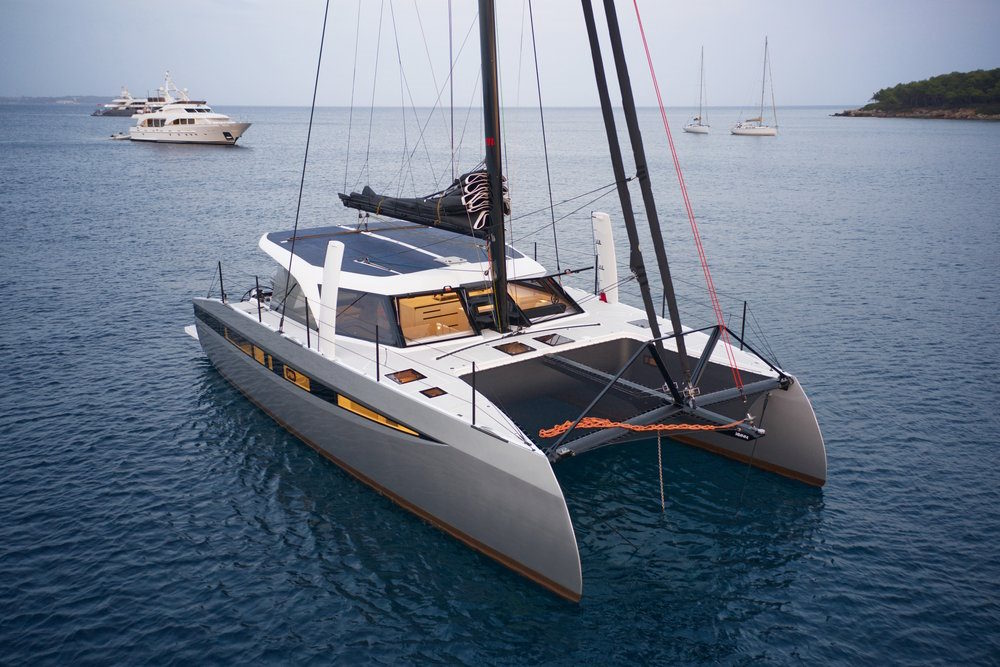
Description
The first HH44 was launched in 2023 and premiered at the Cannes International Yachting Festival. This innovative design is the “baby” of the HH Catamarans range and has some interesting features such as her closed transoms, swing aft helms and a side boarding gate aft.
She’s a very pretty cat and will turn heads in the marina. This is HH’s first hybrid electric-powered catamaran although you can also opt for standard diesel power with shaft drives.
There are 2 versions, like much of the HH range. The Sports Cruising model: HH44-SC and the Ocean Cruising model: HH44-OC. The SC version is a “no-compromise-boat” with C-shaped carbon daggerboards, a carbon rig, a painted hull finish and 4,232 watts of solar with EcoDrive.
The OC saves you some money with the same hull, interior fit and finish quality as the sportier SC but with an aluminium mast, e-glass longeron, white gelcoat finish and mini-keels as standard.
Many of the ideas on this boat have been driven by a desire to maximise solar generation. There are 4,232W of peak solar on the cabin top alone with an option for more on the davits.
To maximise the solar, they have positioned the helms aft in a traditional sporty set-up. That way, there’s plenty of surface area up top to load on solar.
To help you stay protected in weather, these swing inboard, under the long coach-roof.
There are foldaway seats that tuck into the sides allowing you to either steer the boat from an outboard position with the wind in your hair and your sails’ tell-tales in full view.
Or swing the helms inboard and steer from the protected three-seat sofa on the aft beam.
To make it easy to board the boat in the marina, there is a side gate aft for when you come in along the dock.
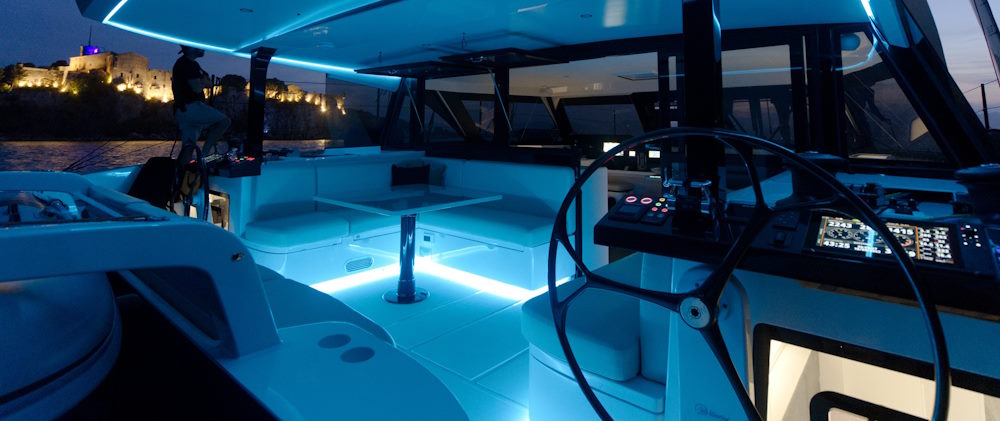
The HH44 has been designed to sail. The whole idea behind this catamaran is to get sailing in light winds (you should match wind speed on a beam reach) and to maximise your SOG over a wide range of conditions.
So she has a self-tacking staysail, a solent, a fractional reacher and a furling gennaker. The boom is very low over the coach-roof which keeps the centre of effort from the mainsail low.
There is a traveller aft on the coach-roof to manage your mainsail shape. The HH44 points well into the wind (45 TWA) thanks to her C-shaped daggerboards which provide a bit of lift at speed.
All the lines come back to the helm, so she is set up for short-handed sailing.
- Light, rigid and fast, the HH44 is a great sailor
- Swing aft helms give you flexibility while opening up the living space in the aft cockpit
- The finish on this boat is excellent
- Those closed transoms create a safe enclosed living space. They’ll also save you money in the marina
- A great looking boat that should hold her value well in the market due to the high demand
- The EcoDrive strikes a great balance between electric motoring with back-up diesels for safety
- With those aft helms, visibility is reduced towards the opposite bow, although the sight lines through the salon windows is good.
- This is not a cheap yacht
- The forward cabin is cosy. There is an option for a Pullman berth here (or convert to a workspace)
- The bow lockers seem small, although they are deep
Light Construction
Carbon and epoxy have been used to build as strong and stiff a yacht as possible while minimising the weight.
All of the lines run under the decks, so you have clear walkways around the boat. Stanchions are 900mm tall and a continuous, unbroken toe rail runs the length of the deck with all hull and deck joints fused and hidden.
Living Space
Moving inside, you’ll notice that the aft cockpit and salon forms one fully protected space with a large sofa on the aft beam and her closed transoms make this a safe family boat.
The angular cabin has two large, forward-facing windows that open fully from the the generously sized (187 sq ft or 17.4m2) salon. The standing height is over 2m (6’6”) high throughout.
One of the things that sets the HH44 apart from her competition is the quality of the finish on this semi-custom yacht. She has foam core furniture and exceptional joinery throughout, and Bosch electric appliances as standard.
There are two options for a BBQ, one which replaces the aft sofa with a large LPG BBQ & Dive Tank station or you can mount an LPG Grill in the aft fishing rod holder, keeping the aft sofa. There is an outlet on the aft beam so you can run an electric BBQ.
In the salon, there is an L-shaped sofa with a table forward to starboard and a large nav station/workstation to port.
Tuck yourself into the U-shaped galley behind the nav station or pull out some cold ones from the fridge on the starboard side. The ventilation at anchor is excellent with those huge forward windows.
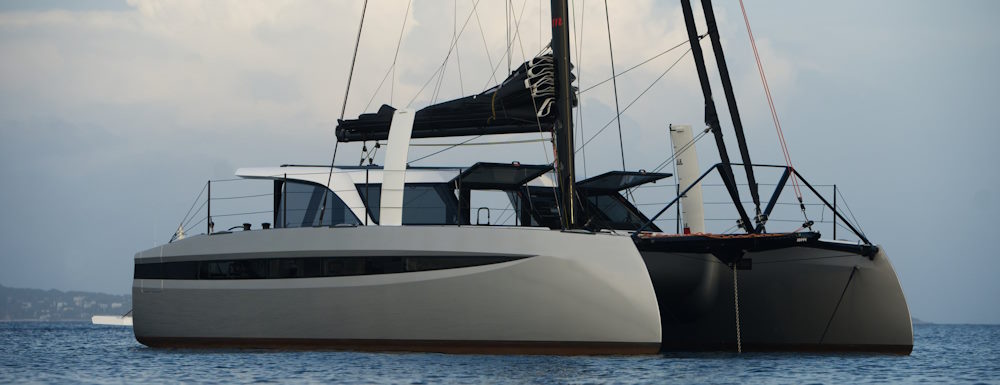
The starboard hull is the owner’s side and consists of the master cabin aft and a walk-in shower and head forward. The finish has an Italian feel to it and it is very light down here with a large window aft in the owner’s cabin.
This is a 44 foot performance cat, so there is not as much room down her as you’d find in a cruising cat, but she has ample space in the aft cabin and the storage is well organised.
HH offers three different forward cabin combinations. One is the standard layout with a single berth.
The second has a Pullman berth above the standard bed that folds away when not needed.
A third option does away with the beds and replaces them with a large work bench with shelves (for pantry storage or tools) and an extra Fridge/Freezer unit.
If you go for the option with the EcoDrive, the House Bank is powerful enough to run the A/C overnight without the need to run a generator. There is enough power to run the A/C in the master cabin for over three days.
EcoDrive, her Electric/Diesel Parallel Hybrid System The HH44 was designed from scratch to work with a parallel electric/diesel hybrid, with a minimum of 4,232W of peak solar array on the cabin top and hydro-regeneration while sailing.
EcoDrive gives you silent fume-free motoring at 7.5kts, fast torque for manoeuvring, and hydro-regeneration while sailing. Plus you have parallel, trusty diesel engines for safety.
A diesel engine is paired with a large electric motor, much like an alternator sits on a traditional diesel engine. A belt links the two units and a camshaft allows you to flip between the two power systems, giving you good redundancy. And remember, you have 2 of these systems on board!
The system is designed to offer from 1.5 to 3 hours of electric propulsion: more than enough time to exit the marina or anchorage and hoist the sails.
This boat has been designed to get sailing in light winds which ultimately is the key to an eco-friendly sailing yacht. And you will be recharging your batteries as you sail.
You can also fit the HH44 with traditional standalone diesel engines with shaft drives.
The HH44 is an innovative design that will appeal to sailors setting out across long distances who want to sail more and beat well to windward when needed. This yacht is in a different price league to something like an Aventura 37 of course, but there are two options here: the Sports Cruising and the Ocean Cruising models.
She’s a comfortable boat, although there is a trade-off on space down below particularly in the forward cabins.
With the EcoDrive option and a bow locker full of sails, you’ll be able to minimise your diesel usage on this boat while crossing oceans safely and quickly.
What is the price of an HH44? How much do they cost? The sportier HH44-SC starts at $1,325,000. Meanwhile the HH44-OC version starts at $957,000 USD. The total cost will vary depending on your options, but you should budget an additional $300k, perhaps more for the SC.
How much solar is there on the HH44? The HH44 has a generous 4,232W of peak solar as standard on the SC on the cabin top. You can fit 1,200W watts over the Davits, but this comes with a weight penalty.
What is the length of the boat with transoms up? With the transoms up, the LOA from davits to Bow Sprit is 14.23m (46.68 feet), so fine for a 15m berth.
What size tender can you carry? The optimum sized tender is 3-3.5m (10-11 foot). The davits are carbon fibre and will soak up a high load.
Technical Specification
Related Catamarans
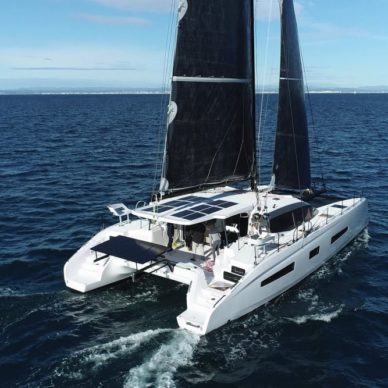
Outremer 55
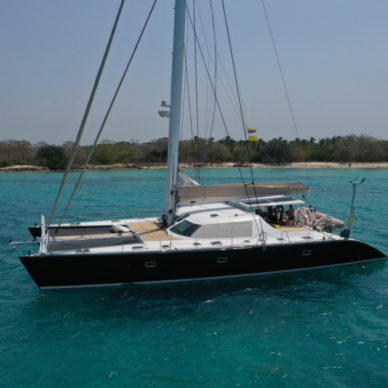
Browse, search and find your perfect catamaran!
Privacy Overview
- Custom Cats
- Performance Cats
- Cruising Cats
- Luxury Cats
- Owner Reviews
- YT Channels

What Are Daggerboards on a Catamaran? (An In-Depth Look)
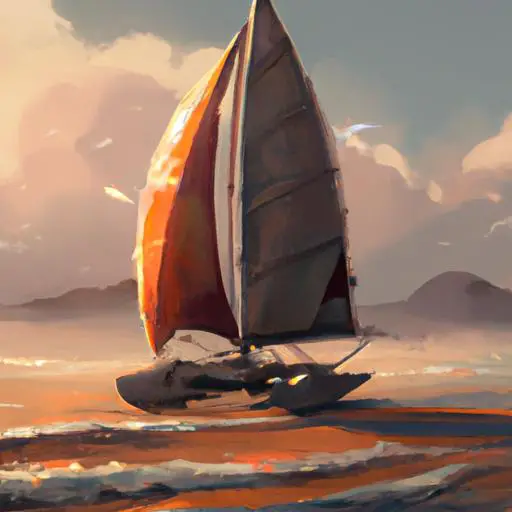
Have you ever wondered how catamarans move so fast and efficiently through the water? The answer lies in daggerboards, a unique and essential feature of these vessels.
Many sailors consider daggerboards to be one of the key advantages of sailing on a catamaran over a monohull sailboat.
If you’re curious to learn more about the science behind this nautical feature, then this article is for you.
Here, we’ll dive into the details of what daggerboards are, how they work, the benefits they offer, the types of daggerboards, and the best practices for maintenance and performance.
By the end, you’ll be an expert on the topic and be able to make an informed decision about the best type of daggerboard for your vessel.
Table of Contents
Short Answer
Daggerboards are vertical boards on a catamaran that can be raised and lowered to provide lateral resistance and stability to the boat.
When the daggerboards are lowered, they provide more stability and can help the catamaran sail closer to the wind.
When they are raised, the catamaran has less resistance and can move faster.
Daggerboards are an important part of a catamaran’s design, as they provide stability and control in difficult weather conditions.
What Are Daggerboards?
Daggerboards are a vertical fin-like structure found on a catamaran, which is a type of sailboat with two hulls of equal size.
Daggerboards are typically located on the centerline of the boat and can be raised and lowered at the skipper’s discretion.
This allows the skipper to adjust the center of effort on the boat, which in turn affects the boat’s maneuverability and control.
At the most basic level, daggerboards provide additional lift and stability to a catamaran, allowing for improved performance in light winds.
They work by creating forward thrust and lift, helping the boat move through the water more efficiently and allowing it to make tighter turns.
Daggerboards also help to reduce leeway, which is the tendency of a boat to drift sideways in the water due to the wind pushing against its sails.
By positioning the daggerboard at an angle, the skipper can reduce the amount of leeway the boat experiences, allowing it to maintain a more consistent course.
Overall, daggerboards are a key component of sailing catamarans and can have a significant impact on the performance of the boat.
With the right setup, they can make a boat faster, more maneuverable, and easier to control in a variety of conditions.
For sailors looking to get the most out of their catamaran, understanding how to use daggerboards is essential.
How Daggerboards Work

Daggerboards, also known as centerboards, are a vertical fin-like structure found on a catamaran.
They are typically located on the centerline of the boat and can be raised and lowered at the skippers discretion.
Daggerboards are designed to provide the catamaran with additional lift and stability in light wind conditions.
This helps to improve the performance of the catamaran by adjusting the center of effort on the boat, allowing for greater maneuverability and control.
When the daggerboards are lowered, they act as an underwater keel, providing additional stability and lift.
This helps the catamaran to cut through the water more efficiently, allowing it to move faster and with greater control.
The daggerboards also help to prevent the boat from drifting sideways in the wind, which can be a common issue with monohulls.
The daggerboards also help to reduce the amount of heeling (leaning) experienced when sailing upwind, making the sailing experience more comfortable and enjoyable.
When the daggerboards are raised, the catamaran will be more maneuverable and have improved performance in light wind conditions.
This is due to the reduced drag caused by the daggerboards not being in the water.
The raised daggerboards will also help to reduce the amount of heeling experienced when sailing downwind, making the sailing experience more comfortable and enjoyable.
The use of daggerboards can significantly improve the performance of a catamaran in light wind conditions and is a key component of sailing catamarans.
By raising and lowering the daggerboards, the skipper can adjust the center of effort on the boat, allowing for greater maneuverability and control.
The Benefits of Daggerboards
Daggerboards are an essential part of sailing catamarans for a number of reasons.
The most obvious benefit of having daggerboards on a catamaran is that they provide additional lift and stability, allowing for improved performance in light winds.
By raising and lowering the daggerboards, the skipper can adjust the center of effort on the boat, giving them greater control over the boat’s maneuverability.
This can be advantageous in tricky situations, such as sailing close-hauled or in tight spaces.
Additionally, daggerboards can help reduce drag in certain conditions.
By raising the daggerboards, the boat can be steered more efficiently by using the hulls to provide lift instead of the daggerboards, which can result in less drag and improved performance.
Finally, daggerboards can help improve the safety of a catamaran.
In rough seas, daggerboards can provide additional stability, helping to keep the boat upright and preventing it from capsizing or being damaged.
This can be especially beneficial when sailing in unfamiliar waters or in bad weather conditions.
In summary, daggerboards are an invaluable component of sailing catamarans.
They provide added lift and stability, can be used to adjust the center of effort on the boat, reduce drag, and improve the safety of the boat.
With all these features, it’s no wonder that daggerboards are a must-have for any serious catamaran sailor.
Types of Daggerboards

When it comes to daggerboards, there are two main types that can be found on a catamaran: retractable and fixed. Retractable daggerboards are typically made of fiberglass and can be raised and lowered at the skipper’s discretion. This allows the skipper to adjust the center of effort of the boat, providing improved maneuverability and control. Fixed daggerboards are usually made of wood or metal and are permanently mounted in the centerline of the boat. These boards provide an extra layer of stability and lift to the catamaran, allowing it to perform better in light winds.
In addition to the two main types of daggerboards, there are also some other variations that can be found on some catamarans.
A daggerboard trunk is a type of daggerboard that is mounted inside the hull of the boat.
This allows the daggerboard to be raised and lowered without having to be removed from the boat.
A foil daggerboard is a type of retractable daggerboard that is designed to provide additional lift and stability to the catamaran, allowing it to perform better in heavier winds.
There are also battened daggerboards, which are a type of fixed daggerboard that is designed to provide additional lift and stability to the catamaran.
No matter which type of daggerboard is chosen, they all provide additional lift and stability to a catamaran, allowing it to perform better in different wind conditions.
By understanding the different types of daggerboards and how they can improve a catamaran’s performance, skippers can make the most of their sailing experience.
Daggerboard Maintenance
Daggerboard maintenance is an important aspect of owning and sailing a catamaran.
It is important to keep the boards in good condition to ensure they are performing as efficiently as possible.
This means periodically checking the boards for wear and tear, making sure they are properly lubricated and free of debris, and ensuring that the fastenings and connections are secure.
Regularly inspecting the boards for signs of corrosion or damage is also important.
If damage is found, it should be addressed immediately to prevent further damage and to ensure that the boards are performing as efficiently as possible.
In addition to inspecting the boards, it is important to keep them lubricated to ensure smooth and efficient performance.
The best way to do this is by regularly applying a lubricant specifically designed for marine use.
This will help reduce friction and keep the boards in good condition for longer.
It is also important to keep the fastenings and connections of the boards secure.
This includes the bolts that attach the boards to the frame, as well as the pins and clips that hold the boards in place.
It is important to inspect these regularly for signs of wear and tear, and to replace them if necessary.
Finally, it is important to keep the boards free of debris or dirt.
This can be done by regularly rinsing the boards off with fresh water after sailing, and by using a soft brush to remove any dirt or debris that has accumulated.
By following these simple maintenance tips, you can ensure that your daggerboards are performing as efficiently as possible and that your catamaran is sailing to its full potential.
Daggerboard Upgrades

The daggerboard is a key feature on catamarans, as it provides lift and stability to the boat.
It is located on the centerline of the boat and can be raised and lowered at the skipper’s discretion.
This allows the skipper to adjust the center of effort on the boat, enabling greater maneuverability and control.
For those looking to maximize the performance of their catamaran, there are several upgrades available for the daggerboard.
A taller daggerboard can be installed to increase the lift and reduce drag, while a lower profile board can provide improved stability.
Additionally, a carbon fiber board can be used to reduce weight, further increasing the overall performance of the boat.
Another upgrade is the addition of a daggerboard trim tab, which allows for more precise control of the daggerboard.
This is especially useful in light winds, as it allows the skipper to adjust the daggerboard to maintain the optimum angle of attack.
This can significantly improve the performance of the boat in light winds.
Finally, there are a variety of shapes available for the daggerboard.
Different shapes are designed to optimize the performance of the boat in different conditions, so it is important to select the shape that best suits your needs.
In conclusion, daggerboards are a key component of sailing catamarans and can have a significant impact on the performance of the boat.
By upgrading the daggerboard, skippers can maximize the performance of their catamaran and improve its overall maneuverability and control.
Daggerboard Performance
When it comes to sailing performance, daggerboards can have a significant impact on a catamaran.
When the daggerboards are up, the center of effort is lowered, allowing the catamaran to sail in light winds with better speed and efficiency.
When the daggerboards are down, they provide additional lift and stability, allowing for improved performance in heavier winds.
The shape and size of the daggerboard also affects the performance of the catamaran.
A wide, shallow daggerboard will provide more lift in light winds, while a narrow, deep daggerboard will provide more stability in heavier winds.
As such, it is important to choose the right daggerboard for your catamaran to get the most out of it.
In addition to improving the performance of the boat, daggerboards can also help reduce drag when sailing upwind.
When sailing upwind, the daggerboards create a venturi effect, which helps reduce the drag on the boat.
This can make a huge difference in performance and can allow the catamaran to reach higher speeds in upwind conditions.
Finally, daggerboards can make a catamaran more responsive to steering.
When sailing downwind, the daggerboards can be used to help the boat turn more quickly and with greater precision.
In this way, the daggerboards can be used to make a catamaran more responsive and agile.
By adjusting the daggerboards, the skipper can adjust the center of effort on the boat, allowing for greater maneuverability and control.
Daggerboards can also help reduce drag when sailing upwind and make the catamaran more responsive to steering.
Final Thoughts
Daggerboards are a key component of sailing catamarans, and their presence has a significant impact on the performance of the boat.
They can provide additional lift and stability, allowing for improved performance in light winds, as well as greater maneuverability and control.
With the variety of daggerboard types, upgrades, and maintenance available, there is something for every boat and sailor.
Understanding how daggerboards work and the impact they can have on sailing performance can help you make the most of your catamaran.
So, take the time to consider the different options and see what daggerboards can do for you.
James Frami
At the age of 15, he and four other friends from his neighborhood constructed their first boat. He has been sailing for almost 30 years and has a wealth of knowledge that he wants to share with others.
Recent Posts
Does Your Boat License Expire? Here's What You Need to Know
Are you a boat owner looking to stay up-to-date on your license requirements? If so, youve come to the right place! In this article, well cover everything you need to know about boat license...
How to Put Skins on Your Boat in Sea of Thieves? (Complete Guide)
There is a unique sense of pride and accomplishment when you show off a boat you customized to your exact specifications. With Sea of Thieves, you can customize your boat to make it look like your...
production Strider 24
plywood Romany 34
lightweight 14ft Zeta mainhull
Strike 15 trimaran at speed
28ft Skoota in British Columbia
10ft 2 sheet ply Duo dinghy
24ft Strider sailing fast
36ft Mirage open deck catamaran
- All Our Designs
- For new visitors
- About Richard Woods
- Useful Articles
- Testimonials
- Plan Updates
- Links to Owners and Suppliers
- Consultancy Service
- Boats for Sale
- Blog and Facebook Posts
- Our Cruising Blog (updated Jan 26th 2020)
- Download Eclipse logbook (300 page pdf)
- Download Newsletters 1992-2002 (pdf)
- Download Year Reviews 2002-14 (pdf)
- Download FAQs (pdf)
- Download Boat Tests (pdf)
Keels or Daggerboards, the pros and cons
When writing about foils (ie boards, keels and rudders) it is easy to baffle people by talking about lift to drag ratios, NACA sections, end plates, twist, stall, Karman vortices and all the rest. So I won't - it's probably best to leave all that to designers and hydrodynamacists Instead I'll try to help those who want to know the basics; like should they have keels or boards on their multihull?
I'm not just a multihull designer; I'm also a (home) boatbuilder and owner. Currently I own two catamarans, one with daggerboards and one with keels. Over the last 30 years I have owned five cruising catamarans with keels, nine with daggerboards and one with one centerboard. Furthermore, I am one of the few designers who has fitted LAR keels and boards to the same hull (on Strider, Sagitta and Banshee) and then sailed them against each other.
As with everything to do with yacht design, leeway prevention is a complex subject. And it is not helped by the fact that boats are not just for sailing. You load them down and treat them as a floating cottage when you live aboard them. You motor them, you dry them out (either when the tide goes out or when stored ashore in a boatyard). And you have to pay for it all.
===========================
First a bit of simple theory
The main factor determining the efficiency of a foil is its "Aspect Ratio" (AR) or the ratio of it's depth to width. I think we all know that a high aspect ratio foil is more "efficient" than one with a low aspect ratio. A 3:1 AR is generally considered ideal for rigs but is usually too high for foils. In fact a 1:1 AR is OK for keels, although 2:1 or a bit more is better. In other words, a 1.5m deep daggerboard on a 10m boat will be about 750mm fore/aft (or more properly called it's "chord"). And it will be about 75mm thick, as the thickness of a foil should be about 8-10% of the chord.
Despite the fact that high AR foils are more efficient, there are a couple of reasons for limiting AR. As the AR increases the chord decreases and so the foil becomes thinner and clearly it is then also weaker. Unfortunately the foil loads have gone up (because the deeper the foil the further the Centre of Lateral Resistance (CLR) is from the bottom of the hull, so the lever has lengthened). So long, narrow foils are more prone to damage (one reason all those monohull keels have snapped off - a J800 lost one just recently).
In addition, the higher the AR the easier it is to stall the foil. When a foil stalls it stops "working", this is most obvious after tacking in a sloppy sea and you find that the boat won't sail properly for a couple of boat lengths. That is because the foil has stalled. In other words, you have to be sailing in flat water and be a very attentive helmsman to avoid stalling a high AR foil.
The lower the AR the bigger the foils area has to be to compensate for the reduced efficiency, however a lower AR is more tolerant of shape, surface roughness and angle of attack (which basically makes it easier to sail)
So how big should a foil be? Roughly 4% of the sail area is a good starting point. Some designers use very small boards. That may be OK in theory, which says that you sail in flat water at maximum speed, but in practice I find you need a bigger board to cope with waves and slow sailing, never mind tacking in a lumpy sea.
Whilst on the dangers of too much theory. Many race boats use sophisticated shapes and low drag sections. Don't use them unless, like top racing boats, you also dry sail your boat. Only the simplest shapes work with a rough surface (even new, clean antifouling is considered rough), these fancy shapes need a smooth, ie a mirror finish, to be of benefit.
I definitely don't like asymmetric foils. True they may give a bit more lift but only one can be used at a time, the other HAS to be raised. So you are carrying around the extra weight of a second board and box plus wasting time adjusting boards after each tack which all makes it not worth the very small efficiency gain.
Many people, especially cruisers, don't mind compromising on performance if it means an easier life, more load carrying and greater protection for the rudders and propellers. And that is why Low Aspect Ratio (LAR) keels are so popular. In much the same way as monohull sailors buy a long keel boat rather than one with a fin keel.
Unfortunately, using LAR keels results in a slower boat and more pitching. That is because to optimize speed you need a hull with buoyancy in the ends, not in the middle (technically you need a high Prismatic Coefficient - Cp). Clearly adding a LAR keel adds buoyancy in exactly the wrong place. Furthermore the midships buoyancy makes the boat pitch more as the hull is more "diamond-like". Having said that the buoyancy in the keel adds to total displacement, so you can carry more gear. And you can use the keel as a water tank/shower sump or even somewhere to fit an engine.
As I have just said, a lower AR means having a bigger foil and so clearly a LAR keel has to have much more area than a daggerboard. Thus the wetted surface area (WSA) is significantly increased, especially when sailing offwind compared to a daggerboarded boat with raised boards. And WSA is the prime source of drag at low speeds. So most designers draw a compromise keel which is smaller than strictly needed to balance the sail forces. But these forces must still balance and this can only be done by having a wider sheeting angle. Which in turn means a LAR boat cannot point as high as one with daggerboards.
So all in all boats with LAR keels are slower on all points of sail and in all conditions when compared to a daggerboarded boat. Say 5deg more leeway and 2deg less pointing. Remember it is hard to tell ones real leeway from looking back at the wake as in a seaway the top 2-3ft of water is blown sideways by the wind. So unless the keel is in deep still water you don't notice that you are drifting sideways until you look at the gps.
Further Design Considerations
Boards can be daggerboards (ie adjusted vertically) or centerboards (ie adjusted by rotating). Even though centre boards sometimes fit better into the accommodation layout and can pivot aft without damage when hitting the ground, daggerboards have proven far more popular. Probably because the centerboard pivot bolt often leaks, while it is very difficult to stop the water surging in the case with the board down, and it is easier for "Stuff" to get stuck in the gap between slot and board, thus jamming the board. A centerboard box/centerboard is probably heavier than using daggerboards. And finally it is harder to remove a centerboard for painting/maintenance.
Angled boards actually take up little interior room and can always be incorporated into accommodation dividers - the nav table bulkhead on a Banshee, the hanging locker on a Sagitta, against the hull side on a Merlin for example. More important is that they then don't bang around in a sloppy sea. Providing the board is angled at under 15deg to the vertical I haven't found any disadvantage in using angled boards. Nor have I noticed any difference between boards placed on the inside of the hull and those on the outside. Certainly there is no advantage in having vertical boards fitted on the hull centerline.
Don't use central boards though the bridgedeck. They simply don't work well. The Prout brothers discovered that in 1953 when they fitted a central board on the prototype Shearwater. By 1954 they had fitted boards in the hulls. The Stiletto catamaran started with a central daggerboard but owners quickly found that converting to ones in the hulls improved performance significantly.
The bottom of a LAR keel should be horizontal, otherwise you'll dry out at angle (OK I know that in many areas boats never dry out, but you want your boat level when in a boatyard) Even worse is a keel that is too short as then the boat can fall forward or aft when people move to bow/stern. Clearly dangerous and damaging to crew and boat.
Building Considerations
Boards are heavy, and more expensive than LAR keels, there's nothing one can do about that. To save weight you can make a short board, so that when down the top of the board is below deck level. Daggerboards can be profiled over their full length. But in that case you need to make the board first, and then make the box round the board. So you need to make expensive boards early on during the build.
The alternative is to profile only the below water portion, leaving the rest rectangular. This means the box is also rectangular, so the board can be made after the box. True, there is some extra turbulence when the board is half raised, but you can negate much of that by fitting a profiled cover plate on the outer side. Also I've found that there are less chance of leaks with a rectangular box and more important, weed, twigs etc are less likely to get between board and case and jam the board.
Many people suggest building a "crash box" to absorb any grounding shock. But be warned! I made one once years ago as an experiment on a dinghy. I ran aground and the board moved back into the crash box, exactly as planned. But then jammed - not part of the plan!! I had to capsize to free the board so I could raise it. Hardly practical on a cruising catamaran!
I haven't used a crash box since, relying instead on a very heavy laminate at the back of the box. My reasoning is that the tapered trailing edge of a board is far weaker than the box and so will always fail first. I proved that when hitting an unmarked reef off Nicaragua and we lost about 300mm x 100 mm of board, yet the box itself was undamaged.
Boards are generally made in timber or foam/glass. I prefer plywood over laminated timber as it is easier to profile. Foam boards are attractive in theory, but it is very hard to stop them warping and getting the correct shape without making a mould first is almost impossible. If you do make a mould you have to join the two halves, and remember boards don't just bend they also twist.
If you can, fit LAR keels as late as possible, this keeps the boat nearer the ground during building and saves a lot of ladder climbing.
What about in use?
Unlike boards, LAR keels are very much fit and forget. So there isn't much to say about keels, except to make sure you have a good sacrificial beaching strip and keep it maintained.
It is sensible to lift the lee daggerboard when reaching, as I have found that most breakages are of the lee board as it gets very loaded at speed. However lifting both boards in a big cross sea is not a good idea as that loads the rudders and that, apart from anything else, makes it heavier to steer, so have both boards half down.
Not being able to lift the lee board for half the time is one reason why I don't like using only one board in one hull. Doing so also means the board is much bigger so there are more local loads and of course it is harder to adjust. And it doesn't seem right to have the CLR so far offline. However if you do fit one board don't fit it in the galley hull as that is always heavier than the other hull.
Lifting the lee board to allow the boat to slip sideways is commonly thought a good idea. I'm not convinced. Tank test work has shown that having a deep lee hull actually helps prevent capsizing. That is because the windward hull lifts to a breaking sea, the sea goes under the bridgedeck and hits the lee hull. Because it is deep it is pushed sideways, which dissipates any overturning energy.
People often think you need a long keel (monohull or multihull) to steer straight "hands off". That simply isn't true. Good directional stability depends on the hull balance. A properly designed daggerboarded boat will sail as straight as a LAR keel one, and have the additional benefit of being quicker to tack and maneuver when necessary.
Finally, if you run aground, you can lift the boards to get off, but remain stuck with keels.
If you don't ever expect to race then keels are OK
If you think crosscut Dacron sails are good enough then keels are OK
If you trail your boat regularly fit dagger boards
If you have wheel steering and inboard engines and expect to dry out often fit keels
If you want the best performance then fit dagger boards, but be prepared to use them
- Yachting World
- Digital Edition

New catamarans: 2021’s most exciting launches
- April 7, 2021
Fast cruising is the theme this year, say Toby Hodges and Sam Fortescue, who look at some of 2021's exciting new multihull launches

2021 looks set to be a bumper year for new catamarans as the trend for fast cruising yachts, which deliver plenty if living space continues. This year there are set to be several new catamarans on the market, here’s our selection of those about which we are most excited.
A group of wild enthusiasts in the landlocked Czech Republic are the force behind the new IC36 from Independent Catamaran. The debut model is a fully race-tuned cat that aims to appeal to speed freaks as well as performance cruisers. Oh, and it unbolts to fit inside a shipping container or on a trailer!
Perhaps closer in design terms to the Extreme 40 than a traditional cat, the IC36 has super narrow hulls, high displacement bows and an optional rotating carbon rig with composite stays.
A sporty-looking carbon beam braces the bows and doubles as a bowsprit for asymmetric sails. Deep daggerboards help windward performance, and there’s a racy dual carbon tiller providing direct rudder control.
“The first time I saw it, I just felt like it was from one of Jules Verne’s adventures,” says co-founder Jaromír Popek.
The boat has been optimised for electric propulsion with twin 6kW Oceanvolt saildrives and up to 15kWh of lithium-ion batteries giving a range of a couple of hours. Powerful hydrogeneration under sail keeps batteries topped up. For longer spells at anchor , there is also a decent 1.15kW array of Solbian solar panel s which folds away when not required.
As much fun as this boat should be to sail in its Raw racing variant, it is also available with more creature comforts.
The Pacer model has a coachroof, cockpit tent, more storage and cooking and freshwater systems. It can accommodate a reported eight people in the hulls, with a fridge and two-burner hob to port and a shower/heads to starboard. Or you can opt for a fridge and hob in the folding cockpit table.
Construction is in epoxy-glass composite with local Kevlar reinforcement and foam core, helping to keep weight down to less than 3 tonnes (key for trailering). And there are three buoyancy chambers in each hull, which underpin the claim that the boat is unsinkable.
For all the variants, the light weight and high-performance rig means you can sail in a breath of wind. In a blow, the sky should be the limit. Expect reaching speeds of 20 knots plus, particularly if you take the high-modulus carbon wing mast from Pauger.
Specifications:
LOA: 11.00m / 36ft 1in Beam: 6.20m / 20ft 4in Draught: 0.85-2.00m / 2ft 9in-6ft 7in Displacement (light): 2,500kg / 5,512lb Price ex VAT: €295,000 (for RAW) Builder: www.independentcatamaran.com
This new launch from the world’s number one catamaran brand is the largest in the range of ‘regular’ boats, before entering the more luxurious world of the Lagoon 65.
It has been drawn by VPLP and Patrick le Quement, whose design nous has done much to make cats more mainstream. Many of the features, therefore, will be familiar from the smaller boats.
However, that extra length creates more volume below, so the Lagoon 55 can be arranged with up to six true double cabins with ensuite heads. “It’s the first time we have six cabins of the same size and function and a larger flybridge,” explains products developments manager Martina Torrini during a premiere virtual tour of the first model to launch in March.
Another first is the curving steps up from the transom skirt to the aft deck, dubbed ‘the stairway to heaven’. “The surfaces of the transom can be used differently,” adds Torrini. “Not just a way to access the boat, they become in themselves a living area.” This feature extends the size of the cockpit to 25m2, and even offers a plancha grill.
There’s more social space on the huge flybridge (with fridge and bar) and a movable sunpad on the forward part of the coachroof. The boat also features Lagoon’s first ever dedicated forward cockpit, connected to the saloon by a drop-down window.
A 107m2 fat-head main provides grunt, but is coupled with a self-tacking jib. As with all Lagoons, the emphasis is on comfort and ease of use rather than speed and windward pointing ability.
LOA: 16.56m / 54ft 4in Beam: 9.00m / 29ft 6in Draught: 1.55m / 5ft 1in Displacement: 26,500kg / 58,433lb Price: €tbc Builder: www.cata-lagoon.com
Fountaine Pajot Samana 59
Replacing the five-year-old Ipanema 58, this luxurious 59-footer integrates many of the new design features of the 45, which boasted longer, wider hulls that nevertheless showed 10% less drag. Chief among the new attractions is an enlarged cockpit, forward lounge and flybridge, for more socialising space.
“We wanted to emphasise her identity by optimising her interior and exterior spaces to make this 59ft catamaran the equivalent of a larger yacht,” explains designer Olivier Racoupeau.
“Whether it’s the flybridge, the cockpit or the saloon, we’ve worked hard to find harmony between all the living spaces on board, to gain every millimetre inside and outside.”
There’s a door forward out of the saloon, and the option of a hydraulic bathing platform, which doubles up for tender storage. Up to six cabins are offered, and the rare option of putting the galley up in the saloon or down to port. Hull number one is joining the World ARC .
Meanwhile, a new 51 is tipped for launch in 2022, which will focus on sustainability and have 2kW of flush solar panels built into the flybridge.
LOA: 18.21m / 59ft 9in Beam: 9.46m / 31ft 1in Draught: 1.40m / 4ft 7in Displacement: 25,500kg / 56,217lb Price ex VAT: €1,302,900 Builder: www.catamarans-fountaine-pajot.com
The new 42 replaces the Leopard 40, and it draws on the latest design thinking from the larger boats in the range. Like the award-winning Leopard 50, it has continuous hull windows, a hardtop, and contrasting coachroof accents. But it also goes further, with plumb bows and long horizontal chines.
That lounging space on the coachroof adds 65% to the exterior entertainment area. “By integrating the geometry of the lounge into the GRP hardtop, we were able to achieve a lightweight area that added less weight to the boat than one average sized crewmember,” explains Michael Robertson, chief designer at builder Robertson & Caine. It has been cleverly engineered so as not to steal headroom from the cockpit.
In contrast to many modern cats, the Leopard 42 makes a virtue of the separate cockpit and saloon, whose seating is focused on the forward galley. There is lots of glazing and a full-height door out onto the foredeck. Every cabin has a third more floor space and twice the glazed area of the old Leopard 40. Each has an island berth and its own heads with shower.
But it’s not all about space. “Performance potential remains one of the top priorities,” says naval architect Alex Simonis of Simonis-Voogd Yacht Design. “We spend a lot of time refining the rig geometry and the sail layout to boost the efficiency of the rig plan. At the same time, the ongoing refinement in hull and appendage design allows us to create a yacht with better sea motion and more agility.
LOA: 12.67m 41ft 7in Beam: 7.04m 23ft 1in Draught: 1.40m 4ft 7in Displacement: 12,460kg 27,469lb Price ex VAT: €399,000 Builder: www.leopardcatamarans.com
The new entry-level yacht from France’s Neel Trimarans is designed to bring the world of three hulls to a new clientele.
Building on the success of the larger Neel 47 and Neel 51, the 43 takes the fight to the catamaran, with a big superstructure that includes two double cabins as well as a galley and saloon.
There’s a further double cabin forward in the central nacelle, and cosy singles in either bow. A sliding door and window allows the saloon and the cockpit seating areas to be socially connected, although they remain two very different spaces.
The bulkhead helmstation to starboard has commanding views out over the huge coachroof. From the drawings, this appears to allow a tight sheeting angle for the genoa, but brings the mainsheet, which is fastened to the transom, close to the davits and skirt of the central hull.
The main is square-topped with two full battens and there is also a high-performance carbon spar option.
Though the lay-up is in standard foam-cored glassfibre, Neel says it is leaning towards more environmentally friendly construction. Interior joinery is from sustainable Alpi wood and recyclable material.
LOA: 13.11m / 43ft 0in Beam: 7.50m / 24ft 7in Draught: 1.50m / 4ft 11in Displacement: 9,000kg /19,841lb Price ex VAT: €329,800 Builder: www.neel-trimarans.com
Marsaudon Composites has quietly built an enthusiastic following for its TS42 and TS50 catamarans since the smaller boat was launched six years ago.
That these have been the first boats to cross the Atlantic in the last two ARC s has also done its reputation no harm.
The yard is based at Lorient La Base, at the heart of the French offshore racing scene, so it’s perhaps no surprise these designs are lightweight and offer plenty of performance.
The direct tiller steering, which gives a responsive feel to the helm, is an example of the thinking that sets these boats apart from other multihulls and makes them sought after models. Yet they also have enough space both on deck and below to offer very comfortable living.
A 57-footer from the board of Marc Lombard will be the third design to join the stable. It shares the same hallmarks as the existing models, although a wheel steering option will also be offered.
In suitable conditions this is a cruising yacht that can be expected to hit speeds of well over 20 knots.
The hull shape is clearly a progression from the earlier models, while following the same light displacement principles with fine hull shapes. Lombard drew a new shape for the bows to increase efficiency and reduce the tendency for bow-down trim. He told us: “The bows are shaped so that, when the boat is powered up and starts to heel, the lee bow will generate extra lift to push the bow up.”
The additional size makes the interior spaces of this boat significantly larger than those of the 50-footer, especially in the hulls. Much thought has also gone into ergonomics and weight saving, stripping out and simplifying anything that is not essential. CEO Damien Cailliau likes to draw on a quote from Colin Chapman, founder of Lotus Cars: “Simplify, then add lightness.”
As an example, there are no hull linings, which saves weight and complication, but requires extremely neat moulding. “A core competency of Marsaudon Composites is that we produce excellent mouldings,” says Cailliau, “so we don’t need to hide our work.”
Article continues below…


Outremer 4X on test – a high-performance liveaboard cruiser that is built to last
It’s a mix of everything you need for cruising and what you want to feel for performance,” Loïck Peyron said…

Seawind 1260: Lightweight catamaran making waves on both sides of the Atlantic
The Seawind 1260 has been well received in the States, where the brand has a strong following, but these multihulls…
As a low volume builder – only 28 of the smaller boats have been built in total – Marsaudon Composites can offer semi-custom interior arrangements, providing they don’t add unnecessary weight. The boat can also be built with varying amounts of carbon to reduce displacement further.
At the same time as announcing this design Marsaudon launched a rebranding of the range, which will now be known as Ocean Rider Catamarans (or ORC). The new name is a better fit with the qualities with which owners identify than the Très Simple concept that led to the original TS designation.
To underscore the difference between these boats and the majority of catamarans in this size range a tiller has been incorporated in the logo.
Tooling for the ORC 57 is under construction and the first boat is scheduled to be unveiled in September 2021.
Base price ex VAT: €1,085,000 Builder: www.marsaudon-composites.com
Current Marine CM46 & CM52
The founder of RS Sailing , Martin Wadhams, is a racing sailor who now spends more and more time cruising.
Martin and his wife, Amanda, enjoy sailing fast boats and have spent some time looking to upgrade from their Pogo 12.50 to a multihull. Their search for a true performance cruising catamaran – and one that wouldn’t cost seven figures – turned out few viable options.
Australian-based designer Jeff Shionning put them onto some fresh designs he has done for Current Marine, a new South African brand formed from an experienced team of composites experts at Knysna, between Cape Town and Port Elizabeth on the south coast.
It has been set up to build the new CM46 and CM52 in low-volume semi-custom production. On visiting the yard a year ago, Wadhams was impressed enough with the high tech builds to order the second CM46.
He reports that the joinery is all laminated in, there is plenty of opportunity for layout customisation (in three or four cabins) and, owing to the lower labour costs in South Africa, pricing is keen.
Shionning’s CM designs are lightweight, efficient catamarans that should be able to sail well in light breeze and outrun weather systems in the open ocean.
Key features include daggerboards, fine bows, centralised weight of engines and tanks, and high bridgedeck clearance. The rig is also positioned amidships for optimum weight centralisation, while also helping to create a large foretriangle for flying a range of furling headsails. Aluminium or carbon spars and diesel or hybrid propulsion are offered.
Wadhams says there is good stowage space and payload capacity for comfortable liveaboard cruising. “They’re built using post-cured epoxy, carbon, E-Glass and PVC foam-cored laminates – a level above mainstream brands,” he insists. “This brings the construction found in a few larger, high-end boats into smaller-size catamarans.” The first CM46 is a full carbon racing version destined for an Auckland-based owner and is due to launch early 2021. The second boat (for Wadhams) has a more cruising-oriented spec.
Prices ex VAT: CM46 €635,000, CM52 €787,000 Builder: www.currentmarine.co.za
Seawind 1370
Is this the most popular new design of 2021? Although the first of this new 45ft model is not due to launch until later in the autumn, there has already been a phenomenal uptake in orders.
Publicity has been helped by vloggers Sailing Ruby Rose ordering one of the first boats, but a staggering 55 have been sold already. This has led to the Australian/Vietnamese yard establishing a new technical department that is separate from the production department.
European sales manager Jay Nolan says this 13-strong team is tasked with working up every system on the boat and looking at hybrid solutions.
Price ex VAT: €599,000 Builder: www.seawindcats.com
Outremer 55
A contemporary fast cat set up for short-handed world cruising, Outremer’s exciting new 55 launches this winter.
We previewed this VPLP design in our September issue and hope to test it during the spring. Much focus has been placed on weight and stiffness to help increase performance and ensure the boat can sail in the lightest breezes and therefore rarely need engine power.
Price ex VAT: €1,215,000 Builder: www.catamaran-outremer.com
If you enjoyed this….
Yachting World is the world’s leading magazine for bluewater cruisers and offshore sailors. Every month we have inspirational adventures and practical features to help you realise your sailing dreams. Build your knowledge with a subscription delivered to your door. See our latest offers and save at least 30% off the cover price.
FEATURED LISTINGS
TEL: +1 (954)589-2343

Why Daggerboards?
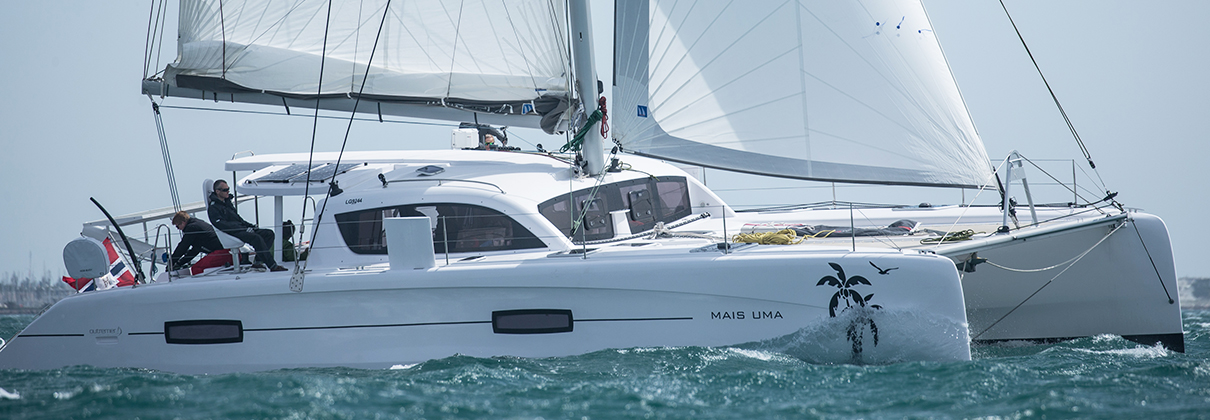
Just Catamarans broker Derek Escher explains how lift works, wind speed, and when to choose daggerboards.
In my teaching courses, I often start out by giving an explanation to students on some very basic level physics about how “lift” works. The idea that a boat can sail into the wind, or that a boat can go faster than the speed of the wind is a foreign concept for many. And, even seasoned sailors grapple with how a sailboat can go twice, three times, even quadruple wind speed! It is perplexing!!
In my brokerage work, I offer nearly the same explanation to customers as I do to my students, that the central purpose of a foil underwater is intended to create lift, while minimizing drag. For one segment of the catamaran market, which is inhabited by brands like Outremer , Gunboat, H&H, Balance, Catana and others, the most effective way to increase performance is to incorporate foils that are highly efficient. In the case of these boats, it comes back to daggerboards. For some catamaran buyers, this is a big thing, for others, not so much.
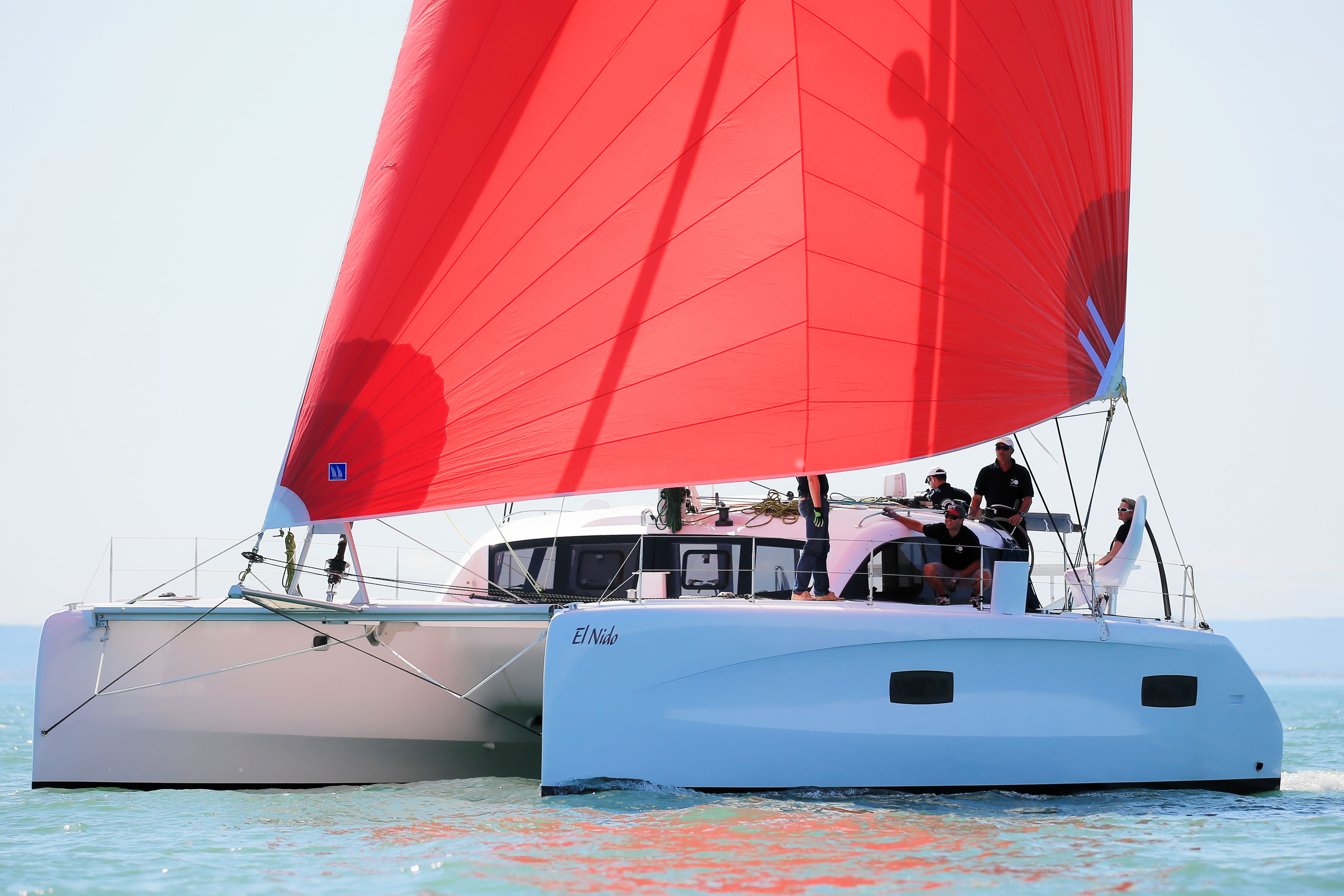
Foils, and lift… In any serious discussion about sailing, we need to understand these terms and concepts. Sails, keels, and rudders are foils. Foils are designed to create lift, and to minimize drag. Look no further than an airplane wing to understand this. An efficient airplane wing is long and skinny. Why? Because it increases lift while minimizing drag. America’s cup cats had wing masts which were very tall and skinny. Why? Because that is where maximum efficiency of a foil lies to create lift. An efficient foil is going to have a high aspect ratio, in other words, it needs to be long and narrow. This, of course, creates some problems in sailboat design. There are many compromises that go into catamaran design, and monohull design for that matter, so this is really good to understand.
What then is lift? Lift is created when a foil, whether it be in the air (aerodynamic) or in the water (hydrodynamic), through movement, creates a high-pressure zone on one side, and a low-pressure zone on the other. The working foil then moves away from the high pressure toward the low pressure. Lift. When a plane heads down the runway at speed, the air is forced underneath the wing, creating high pressure. At the same time, there is very little pressure on the top side of the wing. At this point, the wing moves from the high pressure toward the low. As the speed increases, this force, lift, is stronger than gravity, and the plane takes off.
Here is another way to understand this. Stick your hand out the window while you drive your car (making sure you aren’t too close to any objects of course!). Turn your hand sideways at about 45 degrees to the wind. Your hand will move toward the area that you have protected from the wind. High pressure where the wind hits, low pressure where wind is blocked. If you adjust that concept, you get a foil that creates lift in a desired direction. That is why foils are curved, because we want to lift to be directional, which is behind the curve. Abstractly, this is why you can sail upwind. Your sails, keels, daggerboards and rudders when moving forward into the wind create high pressure of the windward side, and low pressure on the leeward side, and the boat is pulled forward, into the wind. Because the foil directs the boat around the curve of the foil, the boat is lifted forward, and to windward. This is also why airplanes fly. The faster the foil is pushed along, the more lift it creates, and the more efficient the foil becomes.
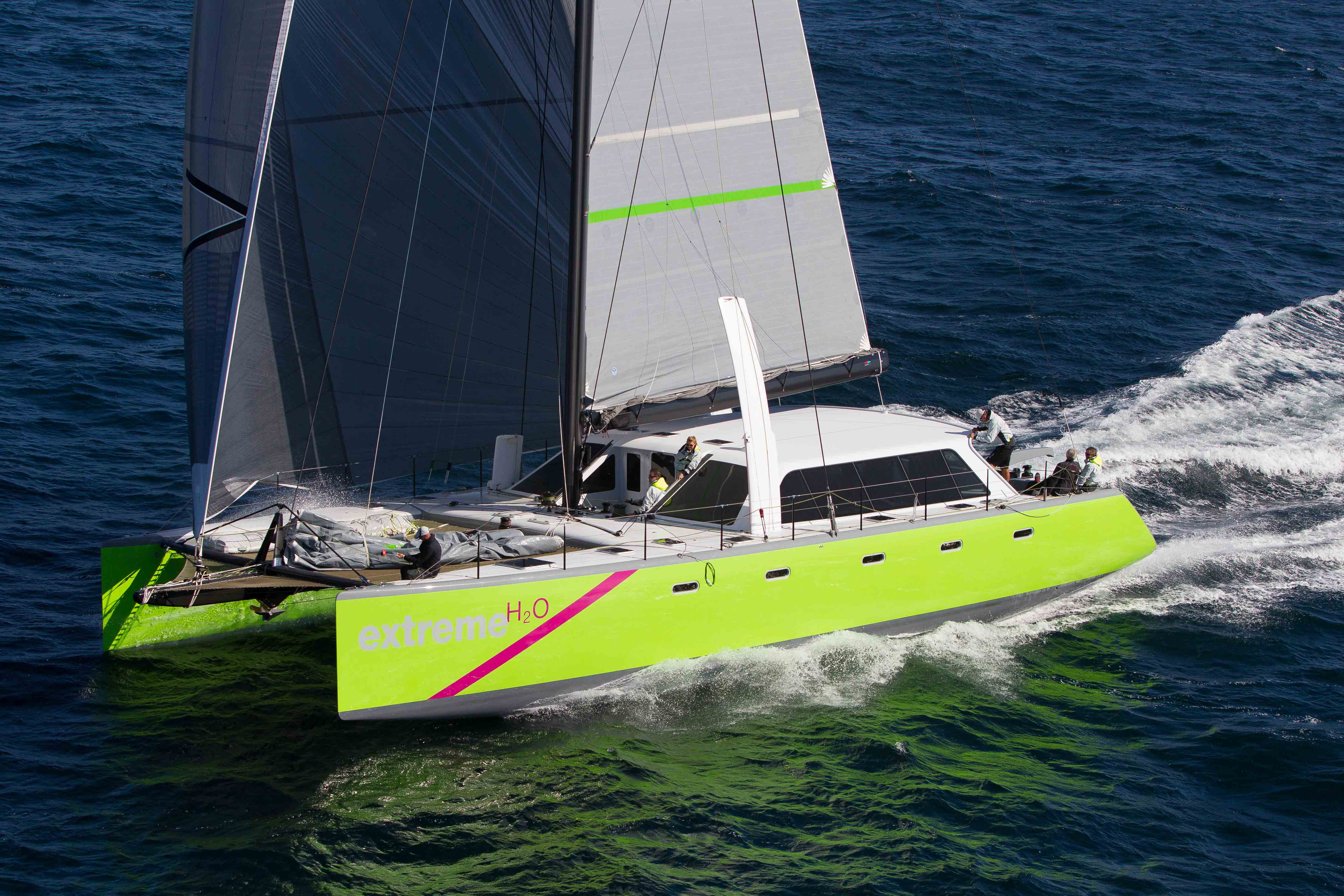
So, how is it that a boat can go faster than wind speed? Let me offer up this explanation. The biggest limiting factor to a boat’s speed is drag through the water. Finding ways to eliminate drag is the key to speed. The more you eliminate, the easier it is for a boat to move fast. This is why more and more we are seeing innovative hull shapes, creative underwater appendages, and even planing hydrofoils on race boats. While America’s Cup style “L” blades (L shape) are not really practical, safe or desirable for cruising boats, “C” shaped blades are starting to be used. This is called foil assist, and essentially what is happening is the blade lightens the boat’s displacement, which in turn decreases the drag the boat has through the water. Obviously, other factors like weight, waterline, and rig are critical to the equation too. How much of this does a cruising sailor want? Up to them! For some, a lot, for many, none. For fun though, let’s try to understand all of this a bit more.
Let’s look at the extremes. America’s Cup boats, Ice Boats, windsurfers and kite boards, etc are super efficient sailors. In each of these cases, virtually all drag has been eliminated. So then what? Well, just picture this: You design a boat, board or iceboat. That vessel has a mind of its’ own!! Seriously! And in the mind of that vessel it has no drag, so every bit of wind it grabs on to, it can go that speed. So here we are, out sailing our super duper vessel, and the wind is on the beam at 15 knots. Our ultra cool vessel thinks “hmmmm, 15 knots, I got this!!!”, and bingo, she’s off at 15 knots!! Except….there is this thing called apparent wind!! So now that we’re going 15, we are actually feeling 25 knots of wind, our speed, plus the actual wind combined. The wind angle now moves forward of the beam, and voila, the boat takes this bet, and states loudly “I feel 25, so I am going to go 25!!”. And sure enough, here we are going 25! Except……now the boat feels 35 knots of wind because the forward speed, plus the true wind combined has increased again!! The angle of the wind moves forward again, so now we are getting pretty tight to the wind, but this whole thing keeps on going, and going, until in the case of the America’s Cup boats, the wind is at 13 degrees off the bow. That’s it! In 10 knots of breeze, Cup boats went 40!! At 13 degrees off the wind (apparent) Ice boats are right in there too. Did you get all that? Confusing, but really cool!
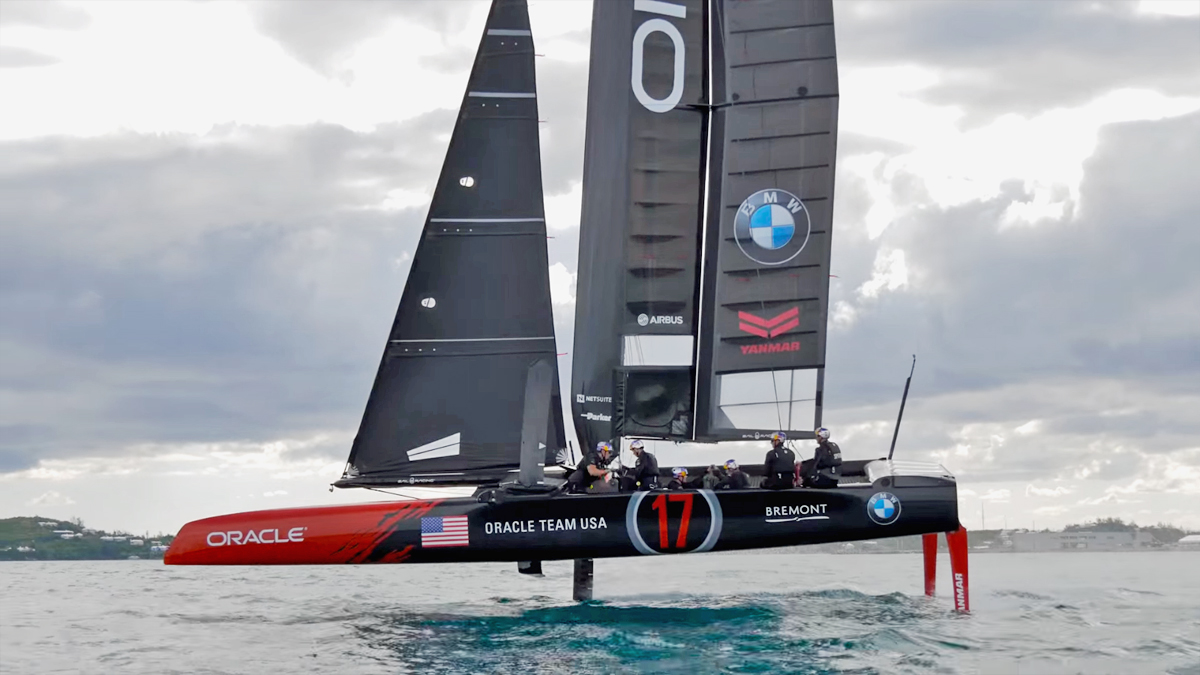
If we understand what lift is, and how foils then contribute to the efficient making of lift, we begin to get a picture of what drives sailboats. I haven’t even mentioned sails, but of course, they do the same thing, and it is very important that they too are as efficient foils as possible, depending on your end performance goals. The higher aspect ratio the sails are, generally, the faster they are.
How does this affect you, and that cruising catamaran you want to buy, or already own? Or, that really tricked out racing/cruising monohull? Well, Cruising cats are phenomenal living platforms. They are stable, comfortable and are highly desirable for many purposes. If in that list of advantages for you is sailing performance, you will need to understand the compromises, and trade-offs of keels versus daggers, of high-quality rigs, and of weight management, and hull design. In monohulls , the lead sled idea is probably going to have to go if you want to maximize boat speed too. You’ll need to get your mono up in the water, cut off some drag, and go from there.
I can teach you how to make your existing keel cat sail better, but I won’t be able to make it into a race boat. Same with your old New England style sloop. Rig balance, VMG, and personal habits can help improve any boat’s sailing properties. A good sailing course and some rudimentary understanding of lift, foils, drag, and discipline will help.
We just have to be realistic about what your boat is designed to do. If you want a 280 mile a day cat, that will go upwind and downwind, you’ll have to give up something too. If you want a lot of lead under you, your speed potential is what it is! There is a world of possibility out there, and no matter which course you choose, you are way ahead of the game to be out on the water as opposed to sitting in an office somewhere, so go get ‘em!!!
Speak with Derek Escher to find the right catamaran for you.

Derek Escher
Licensed + bonded catamaran broker, latest news.
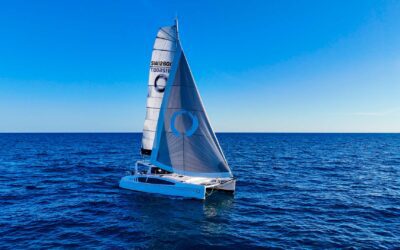
Seawind 1260 INSTANT KARMA Sold by Just Catamarans
darla scott seawind seawind 1260 sold
INSTANT KARMA, a 2018 Seawind 1260 has been sold by Just Catamarans with the help of our brokers Scott Mayer and Darla May.

HELIA2 Outremer 51 Sold by Derek Escher
derek outremer outremer 51 sold
Performance cruising catamaran HELIA², 2022 Outremer 51 sold by broker Derek Escher in an in-house deal.
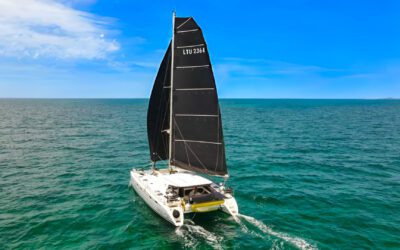
2008 Nautitech 47 HIVA OA Sold by Scott Mayer
nautitech nautitech 47 scott sold
Sold! 2008 Nautitech 47 HIVA OA Sold by Scott Mayer representing the Seller in the deal.

Service Locator
- Angler Endorsement
- Boat Towing Coverage
- Mechanical Breakdown
- Insurance Requirements in Mexico
- Agreed Hull Value
- Actual Cash Value
- Liability Only
- Insurance Payment Options
- Claims Information
- Towing Service Agreement
- Membership Plans
- Boat Show Tickets
- BoatUS Boats For Sale
- Membership Payment Options
- Consumer Affairs
- Boat Documentation Requirements
- Installation Instructions
- Shipping & Handling Information
- Contact Boat Lettering
- End User Agreement
- Frequently Asked Questions
- Vessel Documentation
- BoatUS Foundation
- Government Affairs
- Powercruisers
- Buying & Selling Advice
- Maintenance
- Tow Vehicles
- Make & Create
- Makeovers & Refitting
- Accessories
- Electronics
- Skills, Tips, Tools
- Spring Preparation
- Winterization
- Boaters’ Rights
- Environment & Clean Water
- Boat Safety
- Navigational Hazards
- Personal Safety
- Batteries & Onboard Power
- Motors, Engines, Propulsion
- Best Day on the Water
- Books & Movies
- Communication & Etiquette
- Contests & Sweepstakes
- Colleges & Tech Schools
- Food, Drink, Entertainment
- New To Boating
- Travel & Destinations
- Watersports
- Anchors & Anchoring
- Boat Handling
- ← Seamanship
Sail And Power Catamarans: Developing A 'Catitude'
Advertisement
Once you get the hang of it, multihulls are a blast to drive. Here's how to handle these versatile, comfortable boats — sail or power — for those considering chartering a cat.
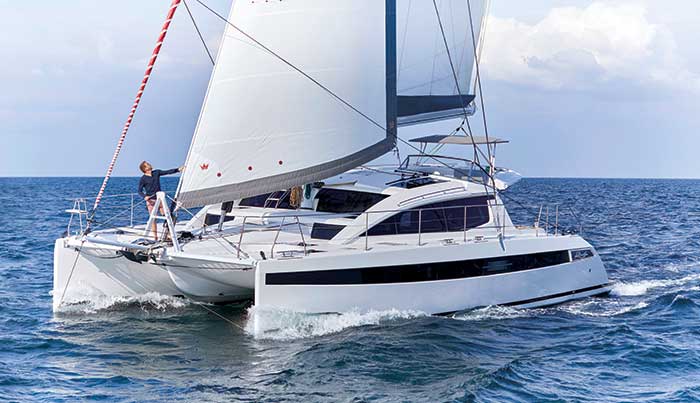
This 43-foot cat is trimmed well for upwind sailing. But once main and boom are eased out to accommodate wind direction, the jib may create a pinched slot as jib tracks are located on cabin tops. (Photo: Privilège Catamarans/Nico Krauss)
As a freelance marine journalist with a U.S. Coast Guard 100-Ton Master license, I get to captain dozens of boats of various designs and sizes. I'm also a cat convert from monohull boating with plenty of firsthand knowledge to share. If you're thinking of chartering or buying a cat, you'll benefit from their inherent advantages. Cats offer more room than the same-lengthmonohulls, they usually have better system access, and sailing cats may be faster in light wind because they're not dragging a heavy keel through the water.
Cats operate upright so you won't be on your ear in a blow. You can cook and sleep on a passage without "walking on the hull" like in a monohull that's heeling. You also spend more time above the waterline on a cat rather than the dreaded "down below" on a monohull.
Of course, for all the pluses, there are minuses: Finding a marina berth for a cat is difficult and expensive. Unlike monohulls that get into the groove and slice through waves when sailing upwind, cats can slap the water if the bridge deck clearance is low, or when the seas meet the underside of the bridge deck.
People who usually sail monohulls may be accustomed to being alerted to the wind rising too much by the increasing heel of the boat. If you get this amount of heeling in a cat, you may be beyond the point of no return; though this isn't as likely with many of today's heavier, wider models. Cats are not self-righting; you have to stay alert to worsening weather.
Also, unless it's a performance model with daggerboards, a cat only has mini-keels, so it won't point high and can be a bit like maneuvering a shoebox. They don't track well, tending to slip to leeward, and they tack slowly because they have to push two hulls rather than one through the eye of the wind. Finally, cats have fairly shallow rudders, so close-quarters maneuvering comes more from dual engine thrust, rather than the water flowing over the rudders — effective, but something to get used to.
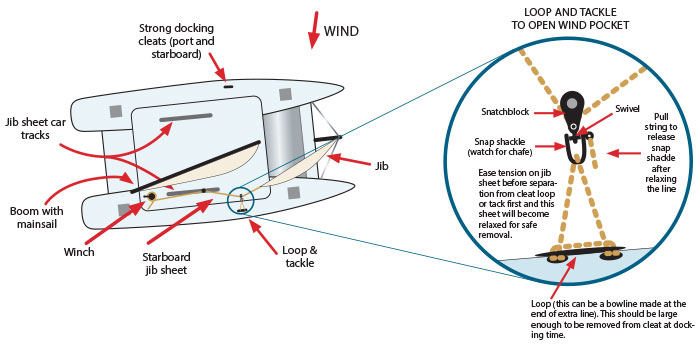
An easy adjustment to position the jib out farther and improve performance is shown in this illustration.
When it comes to the emerging power-catamaran trend, driving cats under power is a straight-up joy. Their two props are set wide apart resulting in much better control and precise maneuvering in close quarters. Cats don't coast like monohulls because they don't have a keel to keep them tracking, so gliding into a dock at a shallow angle doesn't work, and neither does using propwalk to tuck in the stern. You use the engines to spin a cat in its own length or walk it sideways, both of which are easier to master than the nuances of driving a monohull.
Regardless of whether you're docking, picking up a mooring, or anchoring, always keep the boat powered up and ready to drive until you're done because you can't just push a 45-foot cat around by hand. Here are some handling tips that apply to handling both sail and power catamarans.
Don't Ding The Dock
When there's no wind, bigger sailcats also have an engine, which is needed in each hull. They aren't powered to drive as fast, but the principles are the same. Keep in mind, boats and conditions are varied, so we can only give examples here.
- Forget about the wheel when docking side-to or forward. Lock it on the centerline with the wheel lock or by leaning your body against it and maneuver using the throttles (see illustrations below). Power forward with the starboard engine, and aft with the port, and the cat moves to port and vice versa. Turn this around in your head when in reverse. Fine tune adjustments by using one engine at a time. Pause the propeller in neutral when changing directions from forward to reverse and vice-versa to give transmissions time to engage.
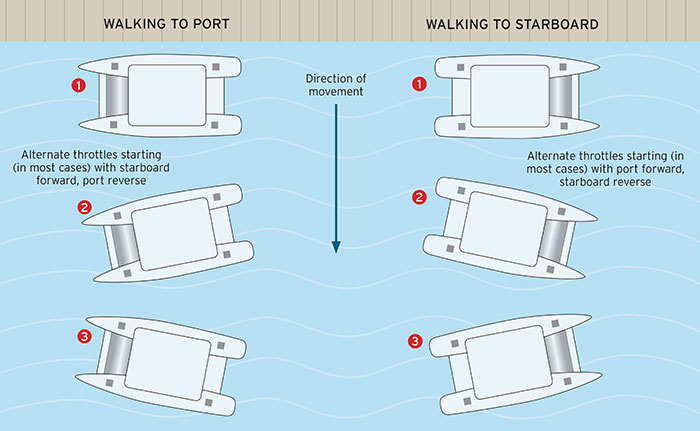
- Backing into a slip: Cats dock stern-to because the bows are high and it's easier to step on and off the dock via the swim platforms aft. When backing straight into a slip, come abeam, pivot 90 degrees with the engines until centered, and back in. If Med-mooring, drop anchor and pay out the rode slowly as you back with both engines. Set the anchor part way back, then keep backing and letting out rode until you're close enough to the dock to tie up the stern lines. Have fenders already tied aft to cushion the transoms. Tighten up on the anchor rode with the windlass.
Wind And Current
As with any boat, it's best to work against the current for better control.
- When departing a starboard tie-up with the current coming at the bow, put a fender and line on the starboard aft corner, power aft with the port engine, pivot, then drive out forward with both engines against the current. If the current is coming from behind, back out, putting a line and fender on the starboard bow. Power in reverse with the starboard engine, pivot, and then back out with both engines.
- Cats have high cabin tops, producing lots of windage. In tight quarters, you may need to turn more sharply when approaching a dock or line up to windward before backing in.
Picking Up A Mooring
Cats have high hulls and it's easy for the skipper to lose sight of a mooring ball before the boat is close enough for the crew to pick it up. Keep the mooring on the side where you can best see forward so you can keep an eye on the ball at all times. (Some cat helm stations are offset to one side or the other.)
- Hand signals or a headset for you and the crew make communications easier to send and receive rather than yelling.
- Have your crew pick up the mooring with a boat hook while you maneuver with the engines to keep station — easier on a cat than a monohulls, even in wind and current.
- Have lines ready by stringing one off a cleat on each hull. To do this, thread each line through the eye or loop, then back onto its cleat. Do this with both sides and adjust until the mooring sits on the centerline. This will minimize swinging and chafe, and noise in the forward cabins.
Anchoring is generally easier on a cat than a monohull. There's more room forward for crew to work, and you can keep the boat steady with the engines.
- A bridle should be preset with a line from each hull (under the trampoline) and hook or shackle in the middle. Once the anchor and chain is down, attach the bridle to the chain (usually done near the windlass) and set the hook putting the pressure on the bridle. Once set, let out enough chain to create a catenary.
- When raising anchor, take care to keep the chain in between the bows or you risk damaging the fiberglass by shaving the bottom of one or the other if you overrun the chain or lose track of where it is. Crew communication is critical.
Sail-Specific Cats
Here's how to coax the best out of a sailing catamaran:
- Big cats carry huge mainsails, so raising one typically requires an electric winch. It also may be challenging to keep full battens out of the lazyjacks that hold up the sail bag, so it can take a few people to raise a large sail. Also, there are usually multiple angles to the way halyards are run on cats with flybridges, resulting in friction. So "dropping" the mainsail can be more like "pulling" it down. Attach a messenger-type line to the mainsail head so it comes down easier.
- Reefing can be a guessing game because you don't feel a cat being overpowered like you do a monohull. Depending on the direction of sail and the sea state, you may be able to reef a little later with the wind a few knots higher — an individual call.
- Cat headsail tracks are typically on the cabin top making the sail curve back on itself, creating a wind break when it's sheeted in. A trick is to bring a spare line from the jib clue out to a cleat on the side deck to open up the slot to let air flow through. Check for chafe on the cabin and don't forget to release it before tacking.
- The majority of multihulls are built to sail on a beam or broad reach, and that's where they're the happiest. Dead downwind, cats shimmy a little making wing-on-wing sailing tricky, not all that different from monohulls. For more comfort, choose one broad reach or the other, then jibe when necessary.
- Cats with daggerboards can point higher and track better because, like monohulls, they have an appendage (or two) down low in the water for a better center of lateral resistance. Daggerboards are mostly used when sailing upwind, and it helps to keep the leeward board lower than the windward one. Sailing downwind with the boards lowered could create a tripping hazard, especially in rough seas where it's possible to stuff the bows into the wave ahead. When motorsailing, a trick to saving fuel and pointing higher is to run only the leeward engine for a little pointing assist.
Next time you have an opportunity to test drive a power or sailing cat, or to charter one on your next holiday, try it! The learning curve is so quick, it's really fun, and before you know it, you, too, may convert to being a cat person!
Catamaran Brands
You can further explore the array of catamarans, big and small, power and sail, by visiting any of these leading manufacturers.
- Aquila Power Catamarans
- Aspen Power Catamarans
- Fountaine-Pajot
- Horizon Power Catamarans
- Leopard Catamarans
- Nautitech 47 Power
- Balance Catamarans
- Fountaine Pajot
- Outremer Catamarans
- Seawind Catamarans
Related Articles
The truth about ceramic coatings for boats.
Our editor investigates the marketing claims of consumer-grade ceramic coatings.
Fine-Tune Your Side Scan Fishfinder
Take your side-scanning fishfinder off auto mode, and you’ll be spotting your prey from afar in no time
DIY Boat Foam Decking
Closed-cell foam flooring helps make boating more comfortable. Here’s how to install it on your vessel
Click to explore related articles
Zuzana Prochazka
Contributor, BoatUS Magazine
Zuzana Prochazka is a freelance journalist specializing in writing, editing, and photography in boating and travel publications. She writes for a dozen boating magazines and websites and a growing list of travel publications. She enjoys combining her passions, which include seeing the world, sailing the oceans, and sharing her experiences through the written word. She holds a U.S. Coast Guard 100 Master license.
BoatUS Magazine Is A Benefit Of BoatUS Membership
Membership Benefits Include:
Subscription to the print version of BoatUS Magazine
4% back on purchases from West Marine stores or online at WestMarine.com
Discounts on fuel, transient slips, repairs and more at over 1,200 businesses
Deals on cruises, charters, car rentals, hotel stays and more…
All for only $25/year!
We use cookies to enhance your visit to our website and to improve your experience. By continuing to use our website, you’re agreeing to our cookie policy.

- About Aeroyacht
- Aeroyacht Design
- Aeroyacht TV
- Mission Statement
- Aeroyacht Racing
- Favorite Links
- Customer Testimonials
- Office Location
- BUY A MULTIHULL
- Specifications
- Photo Gallery
- Try Before You Buy
- Yacht Ownership and Demo Sails
- BUY A POWER CATAMARAN
- Yacht Business Ownership FAQ
- MULTIHULLS FOR SALE
- Aeroyacht Superyacht Catamarans
- Global Multihull Search
- Buy A Multihull
- Sell a Multihull
- Multihull News
- Publications & Articles
- Commissioning & Delivery Services
Multihull Keels and Daggerboards

Fountaine Pajot BELIZE 43 resting on her keels, showing good bridge deck height
Uncovering the compromises of both underwater appendages and analyzing their disadvantages and merits.
Man has learned much from nature, and sailboats and their underwater appendages are one of the areas that we have applied what works and what doesn’t. As we all know, boats – as most things in life- are compromises and often we are prepared to make concessions in one area in order to gain an advantage in another. Not only should this brief discussion illustrate the basic virtues and drawbacks of daggerboards and mini keels on multihulls, but also point out their active and passive safety aspects.
Most multihulls in todays marketplace come in two varieties. By far the vast majority of the production cruising catamarans (about 90%) are keelboats and have low aspect ratio, unballasted keels. These well known French, Australian or S.African boat manufacturers market their boats for private ownership and the charter industry and make a great product. Without sounding too general, these boats have very spacious interiors and are perfectly adaptable for live aboard families or the charter trade. This multi million dollar charter industry, has an obvious influence on the requirements and design of their charter fleet, which further has a trickle down effect to other builders who also market their cats for private ownership. Design parameters for these charter cats are often centered around 2 week multiple family vacations in the steady Trade Winds and day sails between closely spaced islands of the Caribbean. The features of these keel catamarans obviously put less demand on pure sailing performance or extreme upwind sailing characteristics, but rather try to please by offering solid construction, live aboard comfort and simple and reliable handling characteristics.
The other type of multihull is the catamaran with articulating daggerboards or centerboards. Centerboard and daggerboard multihulls both share the same basic concept, except their deployment and storage relies on different principles. The daggerboard lives in a scabbard, or daggerboard trunk. It moves up and down, vs. a pivoting centerboard, which is raised and lowered around a massive pin. High aspect ratio daggerboards are by far the most efficient foils. They have none of the problems associated with centerboards, which when fully lowered are only braced by a small area on top. When going upwind in a hurry, loads on the trunk act as a giant lever, which constantly work to spread the trunk apart. This is the reason why it is recommended to operate foils as pairs in heavier conditions to divide the loads. Also the large area of the remaining centerboard slot creates a lot of unwanted turbulence making them unpopular for performance minded sailors. Lastly declining popularity of the centerboarders can also be lead back to the often large intrusion on the interior space the trunks create. Although the Gemini catamaran is a good example of a very popular and well thought out production catamaran, there are few other mass produced centerboarders around. It should be noted that one great advantage centerboards have vs. any other underbody configuration is that they theoretically retract when colliding with an object. In spite of this, most offshore or performance orientated sailors clearly favor daggerboards or low aspect ration keels.

Illustration A
Daggerboard catamarans have several advantages over their keel counterparts, some of which are well known and others that are more subtle and sometimes only recognized by people who have used them. Active safety aspects are advantages created by speed and the ability to retract underwater appendages.
I am a firm believer of “faster” rather than “slower” on ocean going performance multihulls. Many people might say, going fast is only for racers. But lets think about this. The ability to reduce exposure time through speed is invaluable for cruisers. If say on a transatlantic passage you can shave off 5 days you have already increased your safety factor, in some cases, by 25%. Not being a “sitting duck” is a nice thing indeed. By being able to have the choice, bad weather can be avoided, which can sometimes lead to a negative spiral of incidences. In general, especially on long passages, a daggerboard cat will have the edge on speed over her keel counterpart.
Lets face it, we are all in it for the fun of sailing as famed designer Francis L. Herrshoff said: “The fun of sailing is directly proportional to the speed of sailing”. Maybe this is the reason he designed Amaryllis, his revolutionary catamaran, which was later banned from racing. Generally speaking daggerboard catamarans will always be slightly faster than their keel equivalents. The speed advantage of most daggerboard catamarans vs. keel catamarans though is often exaggerated. On a typical day sail a well trimmed and tuned keel cat will only be slightly slower than a daggerboard cat.
Multihulls lack the feeling of being in the “groove”, which monohull sailors enjoy. Effortless high average speeds, acceleration and sustained high velocity surfs is something fast multihulls compensate with. It should be noted that anything (even a barn door) surfs in the right conditions. Even keel catamarans can surf at speeds up to 30 knots down large seas.
Upwind Advantages: Depending on sea state going upwind, daggerboard catamarans vs. their keel relatives will point up to 5 degrees higher and also experience 2-5 degrees less leeway, which isn’t much one would think. But in an uncomfortable 100 mile beat this ads up to being more than 17 miles closer to your destination! (Illustration B).

Illustration B
sin A=a/c (sin A) c =a (0.1736) * 100 = a a = 17.36 miles
Lets take a 45’ catamaran: the lift (to windward) generated by a daggerboard is almost twice that of a low aspect ratio keel and the drag with the board all the way down would be almost 20% less. The most recent generation cats with large beams and stately bridge deck houses benefit especially from high lift foils, since the windage of their projected area can ad up quickly. The same cats with keels usually suffer from excessive leeway and sideslip. Keel cat’s however, especially in a calm sea state, lessen this disadvantage as boat speed and flow over their keels increases.
Reaching and Running Deep: When running deep in fresh conditions the fixed could act as a brake, that one cannot disengage. Since they cannot be retracted, their volume and resistance slows the boat’s progress and in combination with the forward pressure of the sails forces the bows down. This is especially the case with catamarans that have long bridgedecks, heavy extremities and low volume- fine bows. The bigger the friction in the water, the bigger the pressure on the mast and the more the boat is burdened. Another neat trick is lifting the daggerboards, one can actually increase apparent wind by pointing up and induce leeway, crabbing faster to ones destination.
Tacking and Helm Feedback: Cruising catamarans are often mistaken to tack slowly and behave sluggishly to movements of the helm. This is certainly true for some heavy keel catamarans and much less so for ones equipped with boards. In complex seas, some of the heavier keel cat’s only option for a safe tack is back winding the jib. Monohulls with only one fin will always tack quicker than multihulls, just as foil equipped catamarans will be more responsive than keel multihulls. Modern hydraulic steering systems are easy to build and with most forward helm stations behind the main coachroof, pose sometimes the only alternative for the builder. Mechanical steering and daggerboards will give the ultimate feedback and fun at the helm…if one is driving at all, since usually the autopilot is engaged for longer legs.

Inclined foils on the Aeroyacht H42 performance catamaran built by Edel
Another advantage of daggerboards is the better maneuverability under one engine. If you loose one engine and retract the board on the hull which has no engine power, but leave the powered hull’s foil down, the boat will turn easier. Because of the retracted foil on the un-powered side there will be much less drag induced turning moment, the boat will be more balanced and the other sides deployed board will provide sufficient bite for “survival” steerage. Especially in high crosswind situations a catamaran with both boards down is much easier to maneuver than one with shallower keels. Usually harbor maneuvers under power are low speed operations, and this is where the high lift capacity of twin boards excel yet again and facilitate handling and precision steerage. Daggerboard cats also can motor a bit faster, since by retracting the foils they have less resistance.

Keel and daggerboard cats usually have less draft than keel monohulls, opening access to shallow anchorages. An advantage daggerboards have, are their gauging characteristics when entering shallow harbors or unknown territory. By lowering them, one actually creates a “safety depth”. When they touch bottom one still has the possibility of raising them, performing a U-turn and getting into deeper water. With fixed- non retractable keels, especially with a monohull, groundings or unplanned bottom encounters could end tragic. At least a monhull can attempt in heeling the boat to reduce draft and re float. This obviously is not an option on a keel cat. If you get stuck in the mud you are dedicated to await the next high tide to get you off. Crashing into a coral reef could be a different story altogether and only a haul out can asses and repair damage. Depending on their design, boards could be rotated or flipped, and even repaired underway. In general daggerboard cats also have less draft than keel multihulls allowing access to even more harbors and anchorages. They can be beached high up for repairs or inspections, increasing the window of exposure time between tides. I know, I once performed a 5 hour long emergency repair on our 43’ catamaran this way, saving 1000’s in yard bills and days of headaches.
It should be notes that keel catamarans however, can be beached just as easy as daggerboard cats. They can be left sitting, high and dry, completely safe on their keels, without having to worry about damaging the hulls or getting debris or sea life stuck into the vulnerable daggerboard trunks.
Bruno Nicoletti is an old friend and one of the most low key-expert sailors I know. He has logged more than 130,000 miles (geriatric miles as he calls them) on his 44’ daggerboard catamaran.. At a recent meeting with him in France we talked about his experiences of his record, double handed – one stop- Southern Ocean circumnavigation at age 63. The French Press compares Bruno to sailing legend Vito Dumas and has published his accounts in an article called: “The Impossible Route”. He explained, that in the Southern Ocean, in the most convoluted conditions he would simply raise both boards, lock the helm to windward and lay a-hull with no sails. “Brumas Patagonia” would safely slide down the steep faces of waves and minimally drift to leeward at about 1 mile per hour while he was either resting or reading. The water spoil of his side wards drift would help keep the edge off cresting waves and often prevent them from breaking (Illustration D) While it was blowing 70 knots and higher he felt very safe and in fact the world around him turned peaceful and quiet. His confidence in this system is impressive: I am currently helping him with sea trials on his new 47 footer for a yet another go at a High Latitude – geriatric- circumnavigation. This time he is planning to take his 78 year old brother and do it non stop !

Illustration D
It is not only in the Southern Ocean that one encounters steep, breaking waves. Major capes or the Gulf Stream are notorious for rough conditions where the ability to navigate safely becomes imperative. In these environments any proven and strongly built daggerboard cat would have a slight advantage by lifting her boards, although a well designed keel catamaran could get through unscathed. In extreme weather, and I am talking beyond Force 10, it is very important to enable a catamaran to side-slip rather than encouraging the possibility to trip, and maybe flip. A catamarans behavior in towering side waves is decisive and the possibility to lift underwater appendages is essential, especially if one has lost the ability to steer. The disadvantage of a keel catamaran in huge beam seas is more psychological than real, as these types of vessels typically also slip sideways. In survival conditions or emergencies, the use of parachute anchors, which force the boat into a certain attitude is often thought to be the only answer for most boats. In my mind this tactic is questionable since it puts enormous strains on the boat, is accident prone and renders one helpless when the odd rogue wave from a different direction smacks into the boat. It is better to manage survival conditions, by controlling and slowing the vessel with the use of drogues.
We have learned a great deal from aerospace industry and the trickle down effect to monohull keels. Multihull designers and builders greatly profit from the advanced research, that has been done in the field of NACA sections (National Advisory Committee for Aeronautics) and foil performance. Keels and daggerboards come in a variety of aspect ratios but most are based on low speed foils, which drag/lift characteristics have been optimized. To increase lift even further, some performance catamarans even utilize asymmetrical shaped daggerboards, shaped flat on the outside (leeward) and cambered on the (windward) inside. As they can only be used one at a time asymmetrical boards are somewhat limited in their adaptation for cruisers. (Illustration E)

Illustration E
Since multihulls do not heel, their underwater appendages are more effective in retaining positive flow than their monohull relatives.(this is also the reason why autopilots burn out less often and can be used in heavier conditions on catamarans) As the monohull heels, not only is the upper part partly blanketed by the underbody of the vessel but also flow is lost as the water slips past the angled keel to leeward. (Illustration F) This was especially prevalent on the early IOR monos, which had extremely beamy and shallow bilges and high prismatic coefficient center sections. To compensate for this loss of heel induced flow, monhulls need deep draft keels to make good progress to windward. The keel or daggerboard catamaran on the other hand can more efficiently create lift for the same keel plan view area, not only because it has two vs. one keel, but also through its minimal heel is able to keep its underwater appendages perpendicular in the water.

Illustration F
Usually catamaran daggerboards have a higher aspect ratio and are deeper than the equivalent length monohull, since they have the ability to retract them and therefore have no draft considerations. It is therefore not surprising to see that in wind speeds starting at around 10 knots a well designed and sailed daggerboard cat, will often outpoint and outpace a performance monohull. Even well sailed keel catamarans can often arrive earlier at an upwind destination compared to heavy monohulls. The couple of degrees they sacrifice in their ability to point to windward is often made up by their higher speed and VMG (Velocity Made Good). This performance difference increases proportionally to the wind speed and is very noticeable in F.4 conditions and beyond.
A well known fact and possibly the single biggest psychological deterrent of daggerboard cats is the vulnerability of the boards and trunk in collisions. The true Achilles heel are actually ill constructed and designed trunks, which cause flooding in an impact. This obviously is not the case with keels, which would deflect a minor obstacle, or in case of hitting a container or whale, simply break off. In the case of sacrificial keels, they would sheer leaving the hull completely intact.
Obviously the most critical area in daggerboard design is the construction of the daggerboard trunk. It is usually heavily reinforced with massive gussets, especially at its aft bottom end and extends from the bilge to the overhead. Typical forces on the trunk easily exceed the pressure of the wind on the sails. Dynamic forces of wave action and the shock loads of slamming into seas or solid objects must make this area one of the strongest and best engineered of the entire vessel. Usually the foils are located just aft of the main- mast bearing crossbeam and are somehow tied into this unit to profit from its stiffness. The more “left over” daggerboard remains in the scabbard in the fully down position, the better it is braced, so it is not surprising to see foils that are 18’ long for a 60’ boat. Builders who take their job seriously go through great lengths to make this key area as strong as possible. In a recent conversation with the manager of a reputable French production yard it was pointed out that the daggerboard trunk is engineered and constructed 7 times stronger than the composite board. In case of a violent impact, the foil, which has weak spots designed into it, will snap and leave the daggerboard trunk unscathed. It is a type of sacrificial impact philosophy or a safety fuse, just as it is used on sacrificial fixed keels. The careful engineering and experience necessary in building reliable daggerboard or keel cats stresses the importance of a production yard, which has consistently built them. This aspect should not be taken lightly if one ventures out into the open sea, even if it is only 20 miles offshore.

Often builders of keel cats ad daggerboards to their designs, with the objective to market increased performance and safety. This usually ends up in a compromise, since the hydrodynamic hull requirements of both types could differ substantially, let alone the experience of proper integration, engineering and construction might be lacking altogether. Building with keels does not require the experience, careful construction and engineering which are necessary with retractable foils.
Keels offer advantages, as they do not need to be operated at all. They do their work silently and its usually one less thing to go wrong. On the other hand people who have never sailed with daggerboards think their operation is complicated. In fact they are as easy to use as outhauls or travelers. In normal conditions with 2 people – one pumping the daggerbaords up haul line directly at the board- the other taking up the slack of the up haul, it literally takes 3 seconds to raise a 15’ daggerboard. Single-handed it is a 10 second affair involving 2-3 wraps of the up haul around a winch and 10 cranks. Most boards are slightly heavier than the water they displace and often only weigh 80 lbs. Dropping takes half a second, by simply opening the up haul sheet stopper and easing the foil down. Loads on the boards increase as the speed and pressure builds, so if one has the choice, these maneuvers are usually performed just before tacking. It is a misconception that the operation of foils will depend on the wind speed. It is rather the boat speed, in regards to sea state – which in turn limits progress – which dictates the proper positioning of the daggerboards.
Nothing is perfect and this analysis would be worthless without mentioning the pro’s and con’s of either underwater appendage. Daggerboards, their surrounding structures and systems are more expensive to build, so builders prefer to stay away from them given the choice. In some catamarans, especially smaller ones or ones that have the trunk in the center of the hull, the interior passage in the hulls can be crammed. Lastly it should be mentioned that incorrectly designed and constructed, daggerboards multihulls can be more of a detriment than virtue and in some cases can be extremely dangerous. If the trunks are not massively reinforced and in case of a violent collision one could flood one hull and cause a capsize. In this case one is better off with a well designed and constructed keel multihull than a mediocre or untested one with daggerboards.
Yet daggerboards give you choices, that keels deny you. It is like the new generation of cars with Tiptronic gearboxes, which offer you an automatic transmission with manual override. By physically selecting the proper gear, torque can be adjusted to suit the conditions. It’s the same with the daggerboard equipped catamaran. The boat can be fine tuned to optimize the level of efficiency of the vessels motion through the water. By being able adjust the foils, superior sailing characteristics result in speed and generally more fun on the water. Active safety aspects of reduced exposure time, better maneuverability and shallow draft provide significant benefits.
For safety reasons, most catamarans builders opt for fixed keels and completely separate the keels from the hulls, a feature which preserves and protects the water tightness of the boat in the event of violent impact. Furthermore, if such a situation arises, it makes them easier to repair or replace. Fixed keels require no manipulation, such as daggerboards and give perfect protection to drive shafts, propellers, rudder blades and hull bottoms in the event of grounding. Lastly the absence of a centreboard case means saving of space in the interior of the vessel and usually results in a larger living space.
Back to the birds. We all know the giant Albatross as an extreme example of a sorer that can glide for days in varying conditions, without having to move its wings. This Southern Ocean beast, who calls his home the most inhospitable area on our planet, is better adapted to handle extreme circumstances than any other flying animal. The Albatrosses’ wings are sophisticated in shape, but basically are articulating high aspect ratio foils very similar to daggerboards. Similar to the Falcons “high speed” wings, the Abatross can modify its wings aspect ratio to adjust to the breeze. The designers of the Polynesian multihulls, legendary Viking long ships and American Cargo Schooners understood this too. By adding movable leeway devices, center- or daggerboards, they made their boats more seaworthy and even sailors in the past preferred them over fixed keels.
Today we continue to strive to find the perfect compromise in our vessels to satisfy our most important requirements. We should be extremely thankful to the 1000’s of keel multihulls that have revolutionized the charter industry and many good boats have evolved from this trend. Reputable dagger board catamarans and well designed keel multihulls will continue to be the choice of future generations of serious offshore voyagers. Both offer their advantages and disadvantages and it is important to understand both in order to make the proper choice.
Gregor Tarjan, a trained naval architect and longtime multihull enthusiast is writer of numerous articles for Multihulls Magazine and various other trade publications. He has been involved in Dennis Conner’s “Stars and Sripes” 1984 Americas Cup Campaign, is the founder of Aeroyacht.He is also the co-editor and contributing author of the “Sailors Multihull Guide”, the book by Kevin Jeffrey.
Social Share
Catamaran news.

Planet Sail tests a McConaghy Multihull

Charles Caudrelier wins Arkea Ultim Challenge

Nautitech 48 – Control of the Wind

Boat Test: Nautitech 48 Open catamaran

NEEL 52 Trimaran VIDEO – Sailing at 17 knots
- Catamaran Steering Positions
- Catamarans vs. Monohulls
- Catamaran Learning Center
- Catamaran Speed
- Catamaran Efficiency
- Catamaran Stability
- Catamaran Safety
- Catamaran Shallow Draft
- Catamaran No Heel Sailing
- Catamarans and Seasickness
- Catamaran Space
- Catamaran Boat Handling
- Catamaran Advantages over Monohulls
- Wave-Piercing Bows
- Catamaran Sailing Schools
- Catamaran Insurance
- Catamaran Charter Business and Tax Savings
- Ask the Owner
- 5 Valuable Tips
- Survey Checklist
- Sea Trial Checklist
- MULTIHULLS & CATAMARANS App for Iphone
- Catamaran Surveys
- Multihull Services
- Catamaran Build Consultation
- Financing Services
- Catamaran Repair & Service Facilities
- Catamaran Demo Rides & Shows
- Catamarans for China
- Yacht Design
- Interior Styling & Yacht Art
- Photography

McConaghy MC63 Power Tourer – showing her pace
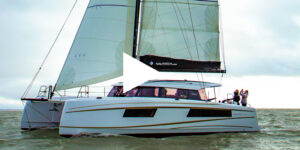
Nautitech 48 Open catamaran – Video

Nautitech 48 catamaran – Interior Design

How the Nautitech 48 catamaran was conceived – Designer Comments.
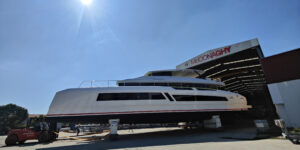
Launched ! – McConaghy MC82P Power
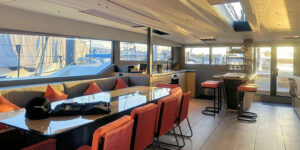
McConaghy 75 catamaran – Stunning NY Loft-Style Interior
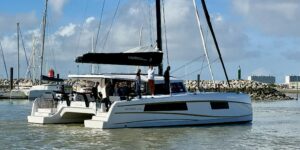
VIDEO: Nautitech 48 catamaran walkthrough. Part 1. EXTERIOR

VIDEO: Nautitech 48 catamaran walkthrough. Part 2. INTERIOR
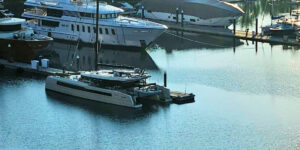
McConaghy 75 Launched.
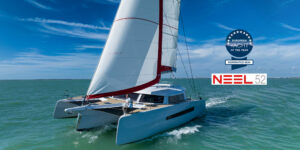
NEEL 52 trimaran nominated European Yacht of the Year 2023
Helpful tips from aeroyacht.
AEROYACHT PUBLICATIONS
Catamaran books by gregor tarjan.

JOIN AEROYACHT’S NEWSLETTER

(215) 508-2704
- Tao Catamarans
- Dolphin Catamarans
- Voyage Catamarans
- All Pre-Owned Catamarans
- Exclusive TMC Catamarans
- Sold Catamarans
- Buying A Multihull
- Selling A Multihull
- Sailing Schools
- Yacht Charters
- TMC Newsletter
- Employment Opportunities
- Mission Statement
- Affiliations
Performance Study of Daggerboards Versus Keels
Story by Phillip Berman / August 17, 2018
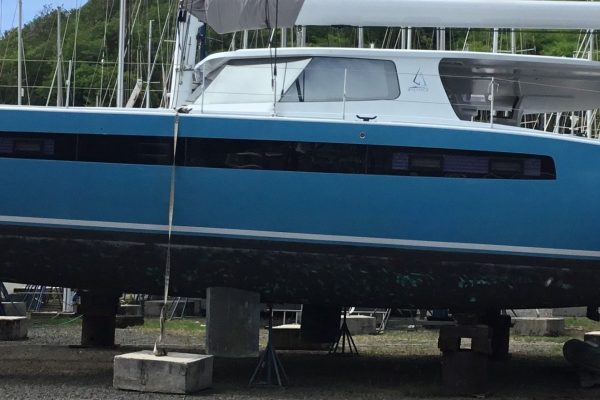
By: Phillip Berman, published with editor’s permission from Boating NZ and Blue Water Sailing
In my forty-five year career in the catamaran industry there’s been a relentless debate on the virtues and vices of daggerboards versus fixed keels. This debate has, however, mostly been waged without “hard numbers” from which to compare performance differences. As we have had requests at Balance Catamarans for both keels and daggerboards, Anton Du Toit (my design partner) and I felt we should conduct a study, the results of which follow.
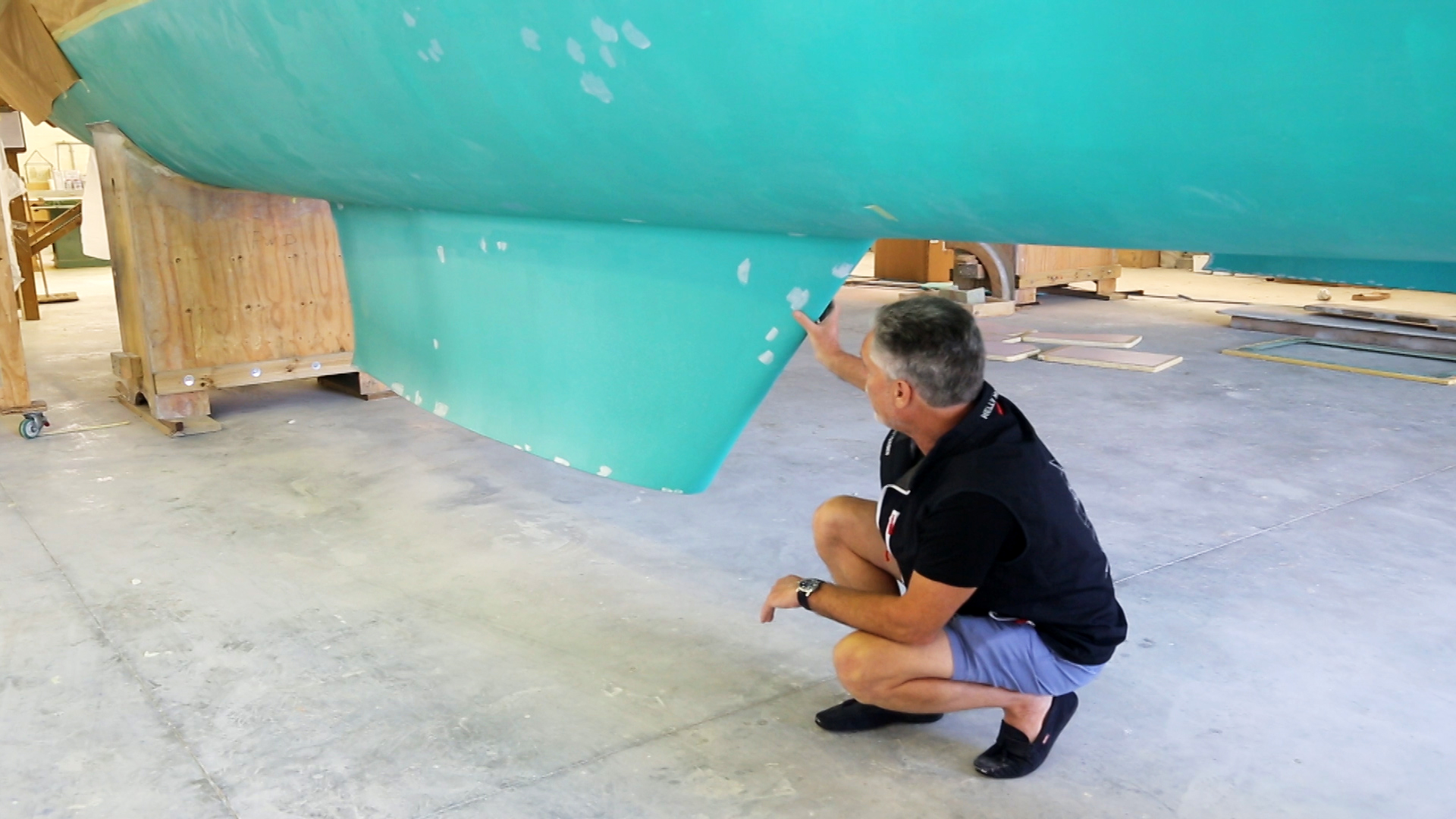
When we first set out to design and construct the Balance 526 we were aiming for cruising couples who wanted more performance and quality than they could find in mass production cats, but also more interior space, payload capacity and ease of use and maintenance than consumers focusing primarily on speed. Our intent was to find the balance – not to create the “lightest and fastest 52” in the world, or the “largest 52,” but a catamaran that could sail swiftly on all points of sail, carry significant levels of payload, yet still be gracious to live on. We also wanted her to be pleasing to the eye.
Our focus at Balance brings us an interesting range of buyers, some of whom are more focused on strength, space, safety and comfort rather than all out speed (cruiser types), others who are more speed focused, less value oriented, and prepared to give up comfort, ease of operation and payload capacity to go a bit faster (racer types). The later sorts of buyers are mostly what I affectionately call “spreadsheet guys.” (Full disclosure: I am not a spreadsheet guy. I am far more focused on how a boat lives, how tough she is, what she can carry, and how simple she is to sail and maintain without a professional crew.)
As we have gone along a few of our customers have asked if we would create the 526 with performance keels rather than daggerboards. They felt that the advantages of keels trumped the performance advantages of boards. We were happy to comply, so Anton set about to design high performance keels for the 526. (Note: On our 451, we only offer her with dual daggerboards and two shallow permanent fixed minikeels. On all other Balance designs it remains customer choice which configuration they wish to have.)
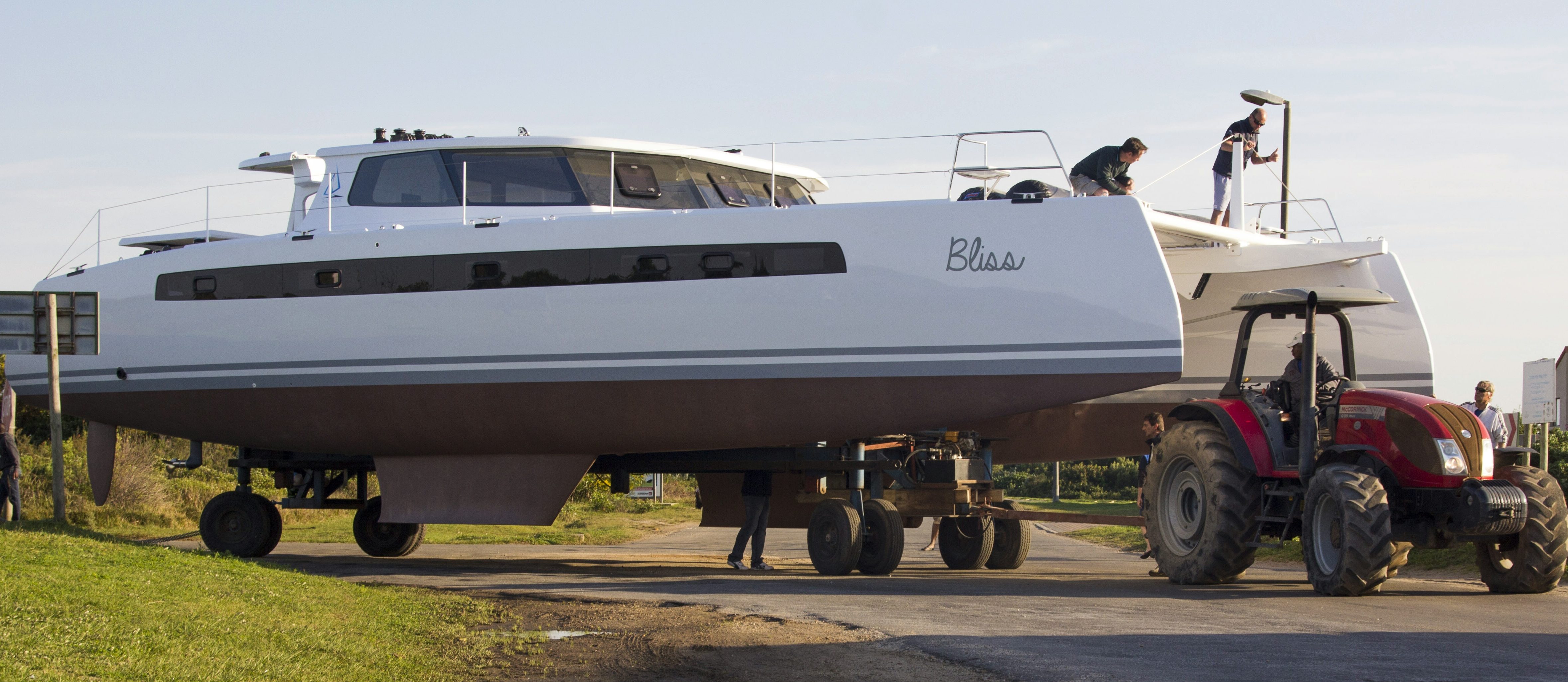
What we were not prepared to do was tell 526 buyers how much faster or slower the two different configurations would be. We felt it best to heed Lord Bryon’s advice to evade “kant and hyperbole” (the language of the day at boat shows!) so we hired the Wolfson Unit for Marine Technology and Industrial Aerodynamics at the University of Southampton to conduct comparative studies of the two configurations on identical 526 models. When you are comparing identical products with just two different variables it seemed a worthwhile study to undertake and share with our customers. It also becomes, to some extent, a worthwhile study for anyone considering a new or used catamaran purchase who is curious how the two different configurations impact performance.
While Anton and I believe these studies can be used by consumers to compare the relative performance differences between boards and keels, it is important to note that the 526 is a very light, narrowhulled epoxy performance cat and the keels we install are considerably finer, deeper and more carefullyshaped than those found on mass production designs. Additionally, we conducted the study with the daggerboards in the fully down position on all points of sail to reduce the studies complexity. The daggerboarded 526 would be marginally faster than the study indicates off- the-wind with boards raised due to a further reduction of wetted surface.
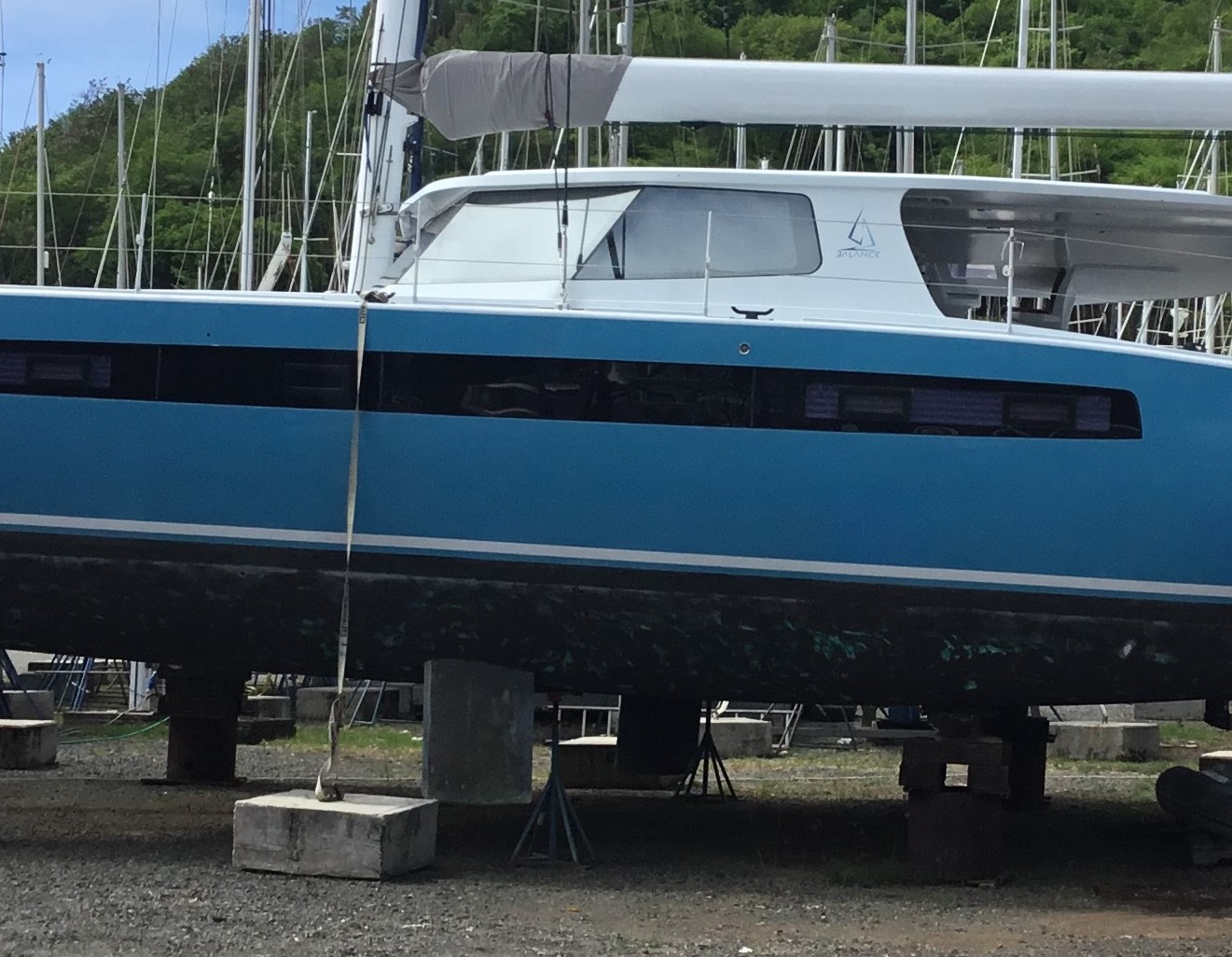
The disparity between keels and boards on a mass-production cat compared to a Balance or any other performance cat would be exaggerated considerably compared to the study that follows. I would note that we erred on the side of caution in setting our lightship weight for this study at 12.5 kg. We have carefully lode cell weighed our 5th boat and the actual lightship weight is 12,215 kg, or 26,930 pounds for the keeled 526 and 12,261 kg, or 27,030 pounds for the daggerboarded 526. Our lightship weight could be lower for customers prepared to put their boats on a diet, or sacrifice quality in several areas, but we have found that they want as much cabinetry as possible, folding tables, glass salon windows, Corian counter tops, and high-end flooring inside and out, etc. Spreadsheet guys miss the mark on this subject constantly in my experience. They also wrongly compare boats based on length, rather than the interior volume of the hulls and bridge – what I call the sum total of fiberglass parts. Regardless, the polars closely mimic the high performance our yachts have proven in real life cruising, fully laden, so this gives us great confidence in the studies accuracy.
Performance, of course, is not the be all and end all, so it is important to examine the advantages and disadvantages of boards versus keels beyond speed. They are as follows:
Advantages to Keels:
- No moving parts. One less thing to operate or break.
- If you ground the boat you hit the keels and they are easily repaired and at a low cost generally.
- You can chock the boat more easily on the hard and it is easier to beach in some circumstances.
- They cost less to fabricate.
- You get more room amidships for additional cabinetry.
- The keels add a bit of buoyancy. On a 526 about 1,600 pounds as our keels are large and mostly hollow inside.
- Daggerboards are typically a bit heavier. On the 526 each board and trunk weigh about 50 pounds more.
- Poorly designed boards and trunks can allow the boards to rattle when they are not under load. Keels do not rattle.
Advantages to Daggerboards:
- Boarded cats point higher and side-slip less as the study shows. I have noted that on keeled production cats you can “stick them up into the wind” but they tend to crab horribly when pinched, as such that you must crack off considerably to reduce leeway and sustain momentum. On most of the sea trials I conduct on production cats we “close reach” to windward on sea trials. This is less the case on deep, finely shaped performance catamaran keels.
- The draft on most keeled catamarans is deeper than the draft on daggerboarded cats. Our 526 keeled version draws about 12 inches more than the daggerboarded version. On daggerboarded cats the rudder tip usually represents her deepest draft. It is important to note that some cats carry very stubby keels to sustain shallower draft, but the shallower the keel the less well she performs when sailing close to the wind. This is important to keep in mind if you are comparing performance on fixed keeled production cats.
- Off the wind with the boards raised to 1/4 there is less drag and the boat steers and sails faster and more playfully.
- The daggerboarded cat is a bit faster and makes less leeway on nearly all points of sail as the study shows in the majority of wind conditions.
- An equally efficient set of keels have much more wetted surface than daggerboards, almost 4 times more. This is the case on our 526 keels.
- Daggerboards set properly can assist in preventing a cat from a “tripping capsize” in very high winds with large breaking cross seas. Both boards can be fully raised, or only the leeward board raised, so the boat can side-slip easily.
- Daggerboarded cats tend to have a bit higher resale value due to the fact that so few are produced in mass production. A buyer that wants boards will only focus on catamarans that have them.

Shifting our focus now to the performance data generated by Wolfson Unit. Their analysis returned the predicted boat speed and leeway angle for the Balance 526 with a keel design and daggerboard design for all combinations of true wind speed from 4 to 25 knots and true wind angles from 40 to 180 degrees. We can begin comparing these two configurations by directly comparing the speed and leeway at major points of sail, specifically beating, close, beam and broad reaching.
While beating the two designs are predicted to perform as follows: To summarize the upwind comparison, the daggerboard design is, on average, expected to sail 1.5 knots faster and 1.75 degrees higher. While close reaching the daggerboard design has less of an advantage than when beating, as can be seen from Table 2:
While close reaching the daggerboard design is expected to sail 0.5 knots faster and 0.75 degrees higher.
As the true wind angle approaches 90° for a beam reach, the keel and daggerboards become more closely matched.
In the beam reaching comparison the daggerboard design will sail slightly higher with a leeway advantage of about 0.25 degrees but it’s speed advantage in 5 knots TWS of 0.3 knots will fade to a 0.5 knot deficit in 16 knots TWS. At this point of sail the two designs are considered to have equal performance as the differences in leeway and boat speed are negligible.
Finally, while broad reaching the following speeds and leeway’s are expected.

In summary, when broad reaching the daggerboard design regains a slight advantage, as it maintains an additional 0.5 knots of boat speed. Leeway differences are again negligible.
Considering the above analyses, it can be seen that the daggerboard design will typically not only outperform the keel design but also out point it, make less leeway close to the wind, therefore giving the daggerboard design a substantial advantage when racing, or for performance focused sailors.
This data gives a fair comparison of the two designs at specific true wind speeds and angles but in order to fully understand the performance trends and enable better predictions between them, one must consider the entire range of wind conditions and all points of sail. This is best done with the use of speed and leeway deltas, where the differences between the two designs are calculated and analyzed.
The following two figures display the average speed and average leeway deltas. The calculation process to determine the deltas is chosen such that a positive value for the delta indicates an advantage for the daggerboard design, and a negative value favors the keel design. For example, a speed delta of +2 knots and a leeway delta of -1 degrees means that the daggerboard design is 2 knots faster than the keel design under the same conditions but would sail 1 degree lower than the keel design.
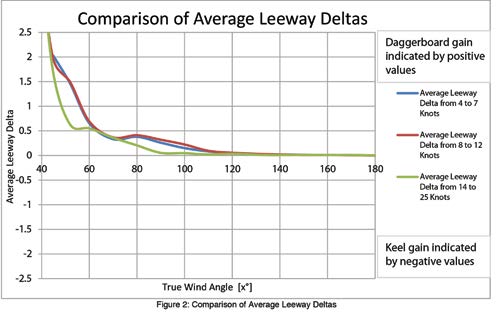
Counter to this, while still on a beam reach but when moving from a low wind condition to a high wind condition, the keel design begins to perform better. This is now taken from the green line (14 to 25 knot TWS range) and gives a -0.6 knot reading. Therefore the daggerboard design is now expected to be about 0.6 knots slower than the keel design under the new, higher TWS conditions.
Figure 2 is used in the same manner as Figure 1 but shows the leeway angle of each design rather than boat speed. Focusing again on a beam reaching condition, the leeway deltas indicate that the daggerboard will always out point the keel design as all three lines (TWS from 4 to 25 knots) indicate. positive values of 0.3, 0.35, and 0.1 degrees at 90 degrees TWA. Overall, Figure 2 shows that the daggerboard design has a significant gain in leeway over the keel design at all wind speeds and angles. This reaches a maximum when beating (TWA ±40-45 degrees) of 2 degrees, and declines to zero when running (TWA ±180 degrees).
With respect to the average boat speed deltas, Figure 1 shows that the daggerboard maintains a higher boat speed when sailing in light and medium winds (red and blue lines in Figure 1). In stronger conditions (green line) the daggerboards yield better boat speed when beating but the keel surpasses this between TWA of 60 to 145 degrees. Keeping in mind that the study was conducted with the daggerboards fully down at all times, in reality, the daggerboards will be raised in the 60 to 145 TWA range. As such the study slightly underestimates the speed of the daggerboard design over this TWA range.
Overall the daggerboard outperforms the keel in both boat speed and leeway in the vast majority of sailing conditions and is thus considered to be the better design choice if achieving ultimate performance is the key criteria. It should be noted that this study is specific to the Balance 526, but corresponding trends can be expected in performance cats of similar size and design.
In the end, and it is a point I cannot stress enough to any boat purchaser, all boats are sets of compromises and trade-offs, and so too with features – helm designs, sheeting systems, rig layouts, bimini designs, bed designs and locations, baths, engine placement, etc. Because I have been deeply involved in brokerage catamaran sales much of my life I recognize there is no one right or wrong boat, certainly no perfect boat, only a boat that happens to be a better fit for a particular sailor and his or her budget, cruising agenda and specific aesthetic proclivities.
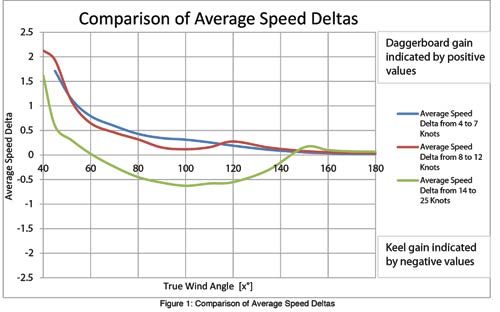
At least now we can say that if someone wants a 526 with keels, here is how she will perform compared to a boarded version. It is then up to the buyer to decide which configuration is the most appealing to them. I will say that, based on the five 526 we have sailing today, with over 60,000 miles of sailing behind them, those owners with keels seem quite happy, just as those with boards.
Alright spreadsheet guys, here’s your numbers to mess with!
Phil Berman is a former Hobie Cat World Champion and the founder of The Multihull Company, a global catamaran yacht brokerage firm. He is also the owner of Balance Catamarans, a boutique brand of high-end performance voyaging catamarans. He can be reached at [email protected] .
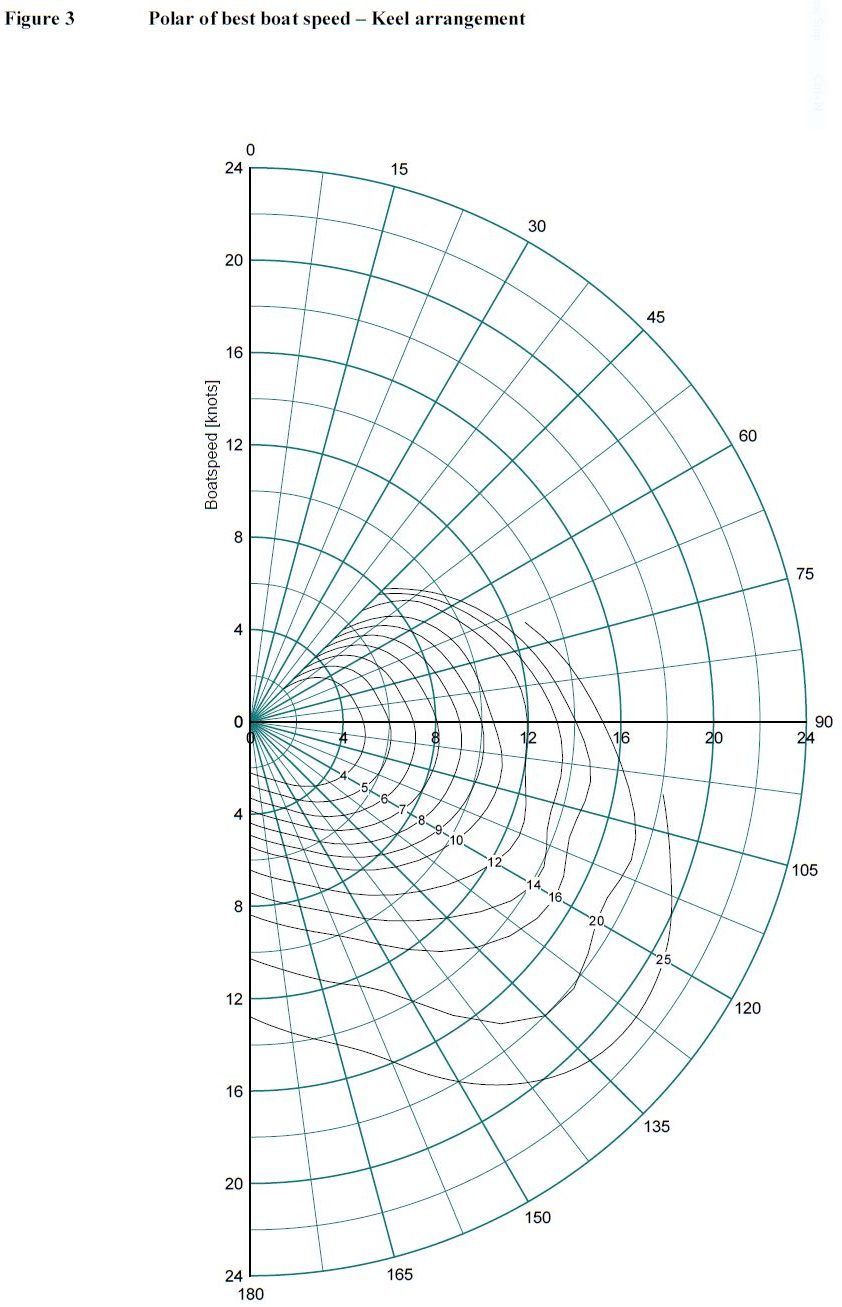
About Phillip Berman
- Are you a Spreadsheet Guy?
- Balance Catamarans is Born: A Bold Move in a Challenging Market
- Can a catamaran really sail upwind?
- Catamaran Depreciation
- Catamaran Vs Monohull
- Daggerboards vs. Keels
- Lessons Learned From A Free Spirit
- Placing a Boat Into Bare Boat Charter
- Post Survey Negotiations
- Saildrives or Straight Shafts? Which is Best For Me?
- Seller's Guide To Yacht Sales
- The 14 Biggest Mistakes When Purchasing a Used Catamaran and How to Avoid Them
- The 14 Biggest Mistakes When Purchasing a Used Cat…and How to Avoid Them Part Two
- The Perils of Internet Catamaran Shopping
- The Ten Commandments of Buying a Catamaran
Recent Posts
The multihull company announces the sale of the first pre-owned balance 482.
- Introducing the Tao 452: On Display At The Annapolis Boat Show October 12 - 15, 2023
Join Us At The Annapolis Boat Show Aboard the Voyage 590
The multihull company announced as dealer for the voyage 590, 6 great starter catamarans, ian edmonson joins tmc as yacht broker in fort pierce, fl., the multihull company opens new office in virginia, the multihull company named exclusive dealer for dolphin catamarans and their new model, the dolphin 380.
- Selling Your Catamaran in Panama
Visit Us at the 2023 Miami Boat Show
Categories: Articles , Articles by Phil Berman , Balance Catamarans , Catamaran Handling , Cruising Lifestyle , Design and Construction
Recent News
The Multihull Company is pleased to announce the closing on the Balance 482 "SeaLife" We wanted to take a moment and thank her new owners on their amazing new catamaran, and to also congratulate our team handling the sale. TMC agent Andrew Hodgdon successfully represented the buyers on the sale of the vessel, while TMC CEO Will Miller represented the...
The Multihull Company is pleased to announce their appointment as a dealer for Voyage Yachts and their new model – the Voyage 590! The Voyage 590 is being celebrated as the ultimate, luxury sailing catamaran with all the comforts of home surrounded by panoramic views of paradise. She maximizes luxury accommodation and comfort, with the performance and blue-water capability characteristic...
In early 2023, Cruising World approached us to seek our opinion on recommending a couple of brokerage catamaran options for first time catamaran buyers to consider when they first stepping into the catamaran market. Here are six boats hand-picked by The Multihull Company’s president and CEO, Capt. Will Miller, as excellent choices for brokerage-catamaran seekers. These are all worth a...
The Multihull Company, the world’s leader in multihull sales and service is excited to announce that it has been named the exclusive dealer for Dolphin Catamarans, a premier builder of high-quality catamarans, and their newest model, the Dolphin 380, designed by Philippe Pouvreau. "We are thrilled to be working with Dolphin Catamarans again and to be able to offer their...
The Multihull Company is thrilled to announce our participation in the Miami Boat Show, taking place on February 15-19, 2023. As one of the premier boat shows in the world, this event is the perfect platform for us to showcase our wide range of high-quality multihulls for sale. We are committed to providing our customers with the best experience possible,...
Introducing the Tao 452: On Display At The Annapolis Boat Show October 12 – 15, 2023
The Multihull Company is thrilled to unveil the new Tao 452, an exciting addition to the world of blue-water performance cruising catamarans. Meticulously engineered and crafted to perfection, the Tao 452 is set to redefine the catamaran experience for sailors worldwide. If you've ever felt the need for more sailing performance from your current production charter catamaran or been disappointed...
The Multihull Company is excited to announce its participation in this year's Annapolis Sailboat Show. The event will be held from October 12 - 15, 2023 in downtown Annapolis, and The Multihull Company will be showcasing the exquisite Voyage 590 catamaran from Voyage Yachts. The Annapolis Boat Show is a highly anticipated annual event that brings together boating enthusiasts, industry...
The Multihull Company is thrilled to announce the appointment of Ian Edmonson as a yacht broker at its newly opened Fort Pierce location. Ian brings a unique blend of boating passion, brokerage experience, real estate expertise, and customer-focused mentality to the team. Ian's love for boating began at an early age and has only continued to grow, leading him to...
We are thrilled to announce that Alan Prater has joined The Multihull Company team as a Yacht Broker in Virginia covering the Hampton Roads area of Virginia. With a lifelong passion for the water and a career spent in the US Navy and as a maritime training professional, Alan brings a wealth of experience and expertise to our team. Alan...
- Read All Articles
We take pride in our happy customers
Your team delivered on every mark. You’ve got an amazing broker in Mark Wattrus and I’m confident you will have continued success moving forward together. He was available 24/7 whenever I had questions. We had a great initial visit on the boat and his marketing plan and photos were superb
I bought a yacht that I had never seen. I did this because I trusted my broker Andrew Holland. It was not an easy job for Andrew, as I am an experienced boat builder and owner of previous yachts, but work in West Africa. Imagine how hard it was to communicate what I was looking for. Andrew came up with exactly what I wanted. He dealt with time delays, all my questions at odd hours, and was there for the survey. He reported honestly and professionally. After buying the yacht, I arrived at the boat on a Sunday night, after dark, after travelling from West Africa to the Caribbean, and found it was better than expected. He never pulled punches and made me aware of shortfalls. I expected to spend my one month leave working on the boat, but actually spent less than one week, and was able to spend 3 weeks sailing – wonderful bonus.
Thank you Andrew for putting up with all my questions, all my worries and all my crazy out of the time zone concerns – you were totally professional, but also I know that if and when we meet up, it will be like a friend finally meeting. You are always welcome on Aseka.
— Beverly Cory
Outstanding company with professional subject matter experts. If I were to buy or sell cruising sailboat, particularly a catamaran, Andrew would be my go to broker.
I have been sailing since I was a child and attended Massachusetts Maritime Academy. But when my wife and I began the process of purchasing an ocean cruising/racing catamaran, I realized that this is a world unto itself. Obviously, we needed to find someone knowledgeable to help us make an informed decision. More importantly, we needed someone honest and willing to put our interests before his or her own. I was lucky to work with Phil Berman at The Multihull Company. He repeatedly shunned the fast buck, choosing instead to work the long road to connect us with the “perfect boat”. I would be glad to recommend Phil and his company to anyone planning to purchase or sell a performance sailing machine.
— Eric Boutiette
Andrew Hodgdon was our broker when we bought our 2018 Lagoon 450F in Antigua in April 2922. He provided great service and was very attentive to our needs. We would highly recommend Andrew and the Multihull Company.
Trust & Expertise About Us
Successful relationships cannot exist without it. At The Multihull Company we base every relationship on a firm commitment to earning and retaining our client’s trust.
Advice of any kind is valuable only when grounded in hard-won expertise. It too, must be trustworthy. Trust and expertise define the heart and soul of The Multihull Company. We are a team of skilled professionals who thrive on providing expert, trustworthy advice and service to catamaran and trimaran sailors around the globe.
Follow us @themultihullcompany
- Pre-Owned Sales
Global Locations
New England +1-267-324-9067
Philadelphia +1-215-508-2704
Virginia +1-757-407-2526
Annapolis +1-703-350-8160
Charleston +1-843-364-4123
Brunswick +1-937-243-2213
Saint Augustine +1-910-477-2508
Fort Pierce +1-904-315-0997
West Palm Beach +1-561-312-0010
Ft. Lauderdale +1-484-744-2740
Miami +1-513-677-5338
San Francisco +1-215-508-2704
Seattle-Tacoma +1-206-297-1151
St. Martin +590 690 58 66 06
Grenada +1-473-457-3245
Puerto Rico +1-787-379-7348
Panama +1-305-735-1661
Trinidad +1-868-680-8909
Croatia +385 95 849 8009
France +33 (0) 6 73 97 17 30
Mauritius +1-215-508-2704
Australia +61 (0)7 5444 4822
Cape Town +1-843-614-2028
© Copyright 2024 The Multihull Company. All rights reserved.
Tugboats left before ship reached Baltimore bridge. They might have saved it.

As investigators work to determine what caused the hulking Dali container ship to topple Baltimore’s Francis Scott Key bridge in a matter of seconds on Tuesday, maritime experts around the country are pointing to what could have stopped it.
These small but mighty vessels tow and push ever-larger ships through channels and help them when their propulsion systems – or lack thereof – cannot. They are standard equipment in ports worldwide and are especially useful to help ships with docking and undocking.
On Tuesday, a pair of tugboats operated by McAllister Towing and Transportation did just that, helping the Dali unmoor itself from the main terminal at the Port of Baltimore and orient the ship toward the open waters.
But they broke away before the massive ship navigated under the bridge , as is common practice. Minutes later, the Dali appeared to lose power and propulsion, sending the craft adrift and directly into one of the bridge’s support columns. The steel-truss bridge immediately collapsed into the frigid Patapsco River.
The accident is igniting debate over the proliferation of “megaships” that fuel today’s commercial transportation industry and whether port protocols have ramped up to safely accommodate them. Although the Dali is average-sized compared to many of these behemoths, the devastation it caused in Baltimore was formidable.
Live updates: Two bodies in Baltimore bridge collapse recovered; search for 4 others ends
Had the tugboats accompanied the ship all the way under the bridge, some experts said, they might have been able to stop, slow, or steer it away from danger.
Such a scenario should be standard operating procedure in all ports, said Capt. Ashok Pandey, a master mariner and associate professor of maritime business at the Massachusetts Maritime Academy. But he said the industry’s reliance on tugs has waned over the years as technological advancements gave many ships the ability to maneuver through channels independently.
Technology is great, Pandey said, until it fails.
“We went wrong by simply equipping ships with bow and stern thrusters that we use in lieu of tugs to maneuver in and out of the ports,” Pandey said. “When we are getting into ports like Baltimore, within a few miles of the bridge, that's too important an asset that we must think of protecting it by all means possible. And we can do that. We can easily do that.”
It may be rare for a ship to lose power at such a high-stakes moment, but it clearly does happen, and he said tugboats could have averted catastrophe.
Implementing such a practice would require a significant investment for U.S. ports, which either own and operate their own tugboats or contract out for tug services. Those costs are then rolled into the ports’ fees charged to shipping companies who use their facilities.
“There are a finite number of tugs, and 99.9% of the time there are no issues,” said Sal Mercogliano, a former merchant mariner and current maritime historian at Campbell University who also hosts a YouTube show called “What’s Going On With Shipping?”
“If the port required tug escorts in and out, then they would not be able to help other ships dock, and undock,” Mercogliano said. “It would need more tugs, and the question becomes, how much will this cost, and will it be passed on to the consumer?”
Because ports compete with each other for shipping business, he said, it’s unlikely that one port would mandate tug escorts unless all of the ports did it for fear of losing lucrative contracts. Shipping companies want the most efficient and cost-effective deal and will simply move to the next port if confronted with higher costs or longer waits.
Mercogliano said he’s not even sure tugboats would have been able to stop the Dali from hitting the bridge. When its power appeared to fail, the ship was going about 8 knots – roughly 9 mph – with a weight of over 100,000 tons.
“It would be like a Prius trying to move a Mack truck on the highway,” he said.
Realities of the container ship arms race
The Dali isn’t even big compared to other container ships hauling goods from port to port these days.
Over the past several decades, newly constructed ships have ballooned to gigantic proportions with load-carrying capacities that used to require five or six ships. The largest container vessel in the 1980s had a maximum capacity of 4,300 20-foot containers – otherwise referred to as TEUs, or 20-foot equivalent units – the standard unit of measurement for cargo capacity.
Today’s largest ship, the MSC Irina, has a capacity of 24,346 TEUs.
The Dali, by comparison, has a capacity of just under 10,000 TEUs, making it the typical “meat and potatoes of container ships,” said Kevin Calnan, assistant professor of marine transportation at California State University Maritime Academy.
Like most container ships, Calnan said, the Dali has one engine and one propeller. Its emergency diesel generator, standard in all such vessels, has enough power to keep key systems going – but not enough to restart the engine or provide propulsion.
In a video posted to social media, lights on the Dali shut off, then turned back on, then shut off again before the ship struck the bridge. Experts said that was likely the generator as it powered up the lights but not the engine.
It would have taken a second engine on board to fully power the ship and restore propulsion at that point. But Calnan said nobody in the commercial shipping industry is advocating for two engines because of their size and cost.
“Cargo is money, and companies want to maximize the amount of space they want to put cargo in, so to build a ship with a whole other engine would be taking up the space of, like, 150 containers on that ship,” he said. “Unfortunately, there’s not too much movement to require these ships to have two engines.”
Calnan, who has worked and sailed on numerous ships during his career, is among the experts who believe tugboats “definitely” could have stopped the Dali from hitting the bridge. He said he has been in similar situations where the power went out and “having tugs there basically saved the day.”
It may take a disaster for industry and ports to change
The bigger the boats and the more sophisticated the technology, the fewer the crew members on board. The Dali's crew is 22-strong.
In his 26 years sailing on commercial ships, Capt. Mike Campbell said he witnessed that shift to smaller crews as automation and electronics made it possible to do more with less when it came to docking, navigating and maintaining the engines.
“I had captains who would turn the radar off in the middle of the day because they didn't want to wear it out, and you'd just go off visual cues, take readings off lighthouses. Now everything is chips and boards,” he said. “And people are more dependent or reliant on it because they are more reliable.”
Campbell, now a professor at the Massachusetts Maritime Academy and master of the training ship Kennedy, said he’s also seen captains push to meet tight schedules, recalling a time when several other chemical carriers owned by competitors sailed out of the Port of Philadelphia into bad weather. His ship stayed put for three days, and arrived in Houston, safely, a day behind schedule. The other ships, he said, all had to sail to shipyards for repairs caused by the storm.
“I was fortunate that the people I sailed under, my mentors, they never worried about the schedule. It was always about the safe operation of the ship,” he said. “You don't want to push things.”
Mariners are always worried about their schedules now, Pandey said.
The shipping industry has become so highly competitive, with companies all vying for a slice of the business, that crews are more likely to leave port without containers than wait on a late shipment and risk falling behind. Ships typically go from port to port, spending anywhere from six to eight hours in each before moving on to the next.
He called it a race to nowhere in which everyone – from the ports to the shipping companies – is playing along.
U.S. ports have spent billions of dollars over the years adapting to the new reality – upgrading their facilities and dredging their channels deep enough to accommodate these massive ships. Some experts warn they could get even bigger in the future, possibly doubling in cargo capacity at some point.
Amid the race to compete for the revenue and jobs brought by these ever-larger ships, port authorities seem to have forgotten about protecting their critical infrastructure, according to Pandley, the former master mariner. He said Tuesday’s accident might be the wake-up call they need to do some real soul-searching.
USA TODAY reached out to the American Association of Port Authorities to ask its thoughts on requiring tug escorts or any other measures to avert the kind of disaster that happened in Baltimore, but a spokesman said nobody was immediately available to take those questions.
Unfortunately, experts said, it often takes a tragedy to improve an industry.
That’s what happened after the 1989 Exxon-Valdez oil spill in Alaska when the U.S. government required double-hull construction for all newly built oil tank ships and all oil tank barges in American waters. California passed a law in the aftermath of that disaster, requiring all oil tankers to have tug escorts in its ports and harbors.
“We have a saying that the laws are written in blood,” said Roland Rexha, international secretary-treasurer of the Marine Engineers’ Beneficial Association, the oldest maritime union in the United States.
“Knowing what we know now, could we have had tugs accompany the ship to the bridge? Sure. But what were the issues that caused the vessel to lose power in the first place?” he said. “There will be an investigation, and we’re hopeful that the lessons learned will lead to an active change in how things are operated.”

IMAGES
VIDEO
COMMENTS
The best cruising catamarans with daggerboards or centerboards provide great cruising capability, comfortable living, ease of handling, and strong construction. Based on different styles, designs, sizes, and prices, some of the best catamarans are Outremer 45, Catana 50, and Balance 526. If catamaran cruising is a passion you have been longing ...
After researching catamarans we have made a list of catamarans with daggerboards. Performance means a great deal for us, so we are looking at the pros and cons of daggerboards, and would like to share our knowledge in this article. If you know of any boats that should be included in this article, please let […]
Having a catamaran with daggerboards means enjoying better pointing ability than an equivalent model equipped with fixed stub keels, which are inevitably shorter. It means that you can also optimize drag, speed and even safety. Partially integrated, with foils...an inventory of the daggerboards on our boats and how to use these appendages.
Every single HH Catamaran daggerboard goes into our monster testing jig and we apply the full force of the known working load to fly a hull with two reefs and the two times "dynamic load factor". So, an HH66 board gets tested to a staggering 17,000kg, which is really scary. Even with our new HH50, the boards are tested all the way to 10 tons.
Retractable daggerboards and electric outboard motors - beachable, higher pointing angles and less drag off the wind. ... Maine Cat is the only production catamaran builder in the world utilizing Core-Cell thermoforming coupled with vinylester resin infusion. The NEW Maine Cat 38 is stronger, lighter, and a blast to sail. ...
Upwind, the daggerboards can push the draft down to just over 13 feet (4.00 m): we suspect that upwind course-keeping will be exceptional. The deck layout has two particularities: firstly, a cockpit that is as wide as it is streamlined, and secondly, twin helm and maneuvering stations at mid-height.
Woods 36 Vardo with Keels. So there's the two factors: one is the the sea kindliness of having daggerboards, and the other is the better performance. A daggerboarded boat is always better, but it does have some disadvantages. The main one is that if you want to beach your boat or dry it out.
The HH60 was born from a desire to take the already-stellar performance up another notch. A taller mast, longer longeron and deeper daggerboards ensure that the HH60 will outperform everything in its class. Every HH Catamaran is built using the very finest, strongest and lightest materials available.
HH50-SC (Sports Cruising) The HH50-SC integrates the very latest in race boat technology but remains equally comfortable and family friendly. This is a "no-compromise boat" with full carbon construction, dual helms, C-shaped carbon daggerboards and stunning performance for its size. Click here to view HH50 brochure.
In very light winds, the standard practice is to lift the windward daggerboard all the way and only trim the leeward board. When both daggerboards are down, (for simplicity) there is now double the 'underwater sail' area. This would likely imbalance how much power there is from the light winds on the sail above the water, and literally ...
Daggerboards. The majority of today's cruising catamarans are equipped with mini keels for reliable and hassle-free operation. There are fewer than a handful of production daggerboard catamarans, which provide the sailor slightly more pointing ability and other advantages as illustrated in previous chapters. Their operation is generally ...
Short answer catamarans with daggerboards: Catamarans with daggerboards are multihull sailboats consisting of two parallel hulls and vertical foils called daggerboards that can be raised or lowered. Daggerboards improve stability, reduce leeway, and increase upwind performance by minimizing side slipping. These high-performance catamarans are commonly used in racing, offshore cruising, and ...
This is HH's first hybrid electric-powered catamaran although you can also opt for standard diesel power with shaft drives. There are 2 versions, like much of the HH range. ... model: HH44-SC and the Ocean Cruising model: HH44-OC. The SC version is a "no-compromise-boat" with C-shaped carbon daggerboards, a carbon rig, a painted hull ...
Short Answer. Daggerboards are vertical boards on a catamaran that can be raised and lowered to provide lateral resistance and stability to the boat. When the daggerboards are lowered, they provide more stability and can help the catamaran sail closer to the wind. When they are raised, the catamaran has less resistance and can move faster.
Currently I own two catamarans, one with daggerboards and one with keels. Over the last 30 years I have owned five cruising catamarans with keels, nine with daggerboards and one with one centerboard. Furthermore, I am one of the few designers who has fitted LAR keels and boards to the same hull (on Strider, Sagitta and Banshee) and then sailed ...
The first CM46 is a full carbon racing version destined for an Auckland-based owner and is due to launch early 2021. The second boat (for Wadhams) has a more cruising-oriented spec. Prices ex VAT ...
Your sails, keels, daggerboards and rudders when moving forward into the wind create high pressure of the windward side, and low pressure on the leeward side, and the boat is pulled forward, into the wind. Because the foil directs the boat around the curve of the foil, the boat is lifted forward, and to windward. This is also why airplanes fly.
A bridle should be preset with a line from each hull (under the trampoline) and hook or shackle in the middle. Once the anchor and chain is down, attach the bridle to the chain (usually done near the windlass) and set the hook putting the pressure on the bridle. Once set, let out enough chain to create a catenary.
Comar's new Francois Perus design with C-foil daggerboards is a tempting blend of speed and comfort, from a yard known for their performance cruising Comet m...
The other type of multihull is the catamaran with articulating daggerboards or centerboards. Centerboard and daggerboard multihulls both share the same basic concept, except their deployment and storage relies on different principles. The daggerboard lives in a scabbard, or daggerboard trunk. It moves up and down, vs. a pivoting centerboard ...
HH Catamarans is excited to confirm that the ever popular Gone with the Wynns sailing YouTube channel have selected the HH Catamarans HH44 for their next boat. ... With its powerful rig plan, extra-large cockpit, king size beds, and deep daggerboards, the HH60 is sure to ignite the imagination. Stop dreaming. Start sailing. Learn More
By: Phillip Berman, published with editor's permission from Boating NZ and Blue Water Sailing In my forty-five year career in the catamaran industry there's been a relentless debate on the virtues and vices of daggerboards versus fixed keels. This debate has, however, mostly been waged without "hard numbers" from which to compare performance differences. As we […]
Centerboards or "swing boards" rely on a pivot point at the top of the board allowing it to swing 90 degrees vertically and retract horizontally in a wet cavity built into the bilges in each hull, while daggerboards penetrate only vertically through bearing boxes in each hull.
The bigger the boats and the more sophisticated the technology, the fewer the crew members on board. The Dali's crew is 22-strong. In his 26 years sailing on commercial ships, Capt. Mike Campbell ...